Presentation Deck Meaning: What is a PPT deck?
The easiest way to understand the presentation deck meaning is that it is a set of slides put together in the form of a presentation, usually for business purposes but also often used in other areas like academic environments or public speaking events. The term “deck” derives from the old analog technology by which a physical set of semitransparent slides (the deck) was placed inside a projector that shone light throw them. That is the root of the slide deck meaning.
These old projectors were later replaced by presentation software and digital projectors, but the term stuck. Microsoft PowerPoint has been one of the most widely known presentation deck tools since its release in 1987. Since then, a deck presentation has almost been a synonym for a PowerPoint deck.
A PPT deck quickly became the industry standard to present information due to Microsoft’s mainstream commercial success in the following decades. Apple products were still considered to target a niche in the market then, and their slide deck software, Keynote, would never harness the massive popularity of PowerPoint decks.
A Power Point deck is one of the most effective ways to navigate different topics, from all-hands meetings to investor presentations. The human brain struggles to remember a lengthy or complicated topic when you are presenting. In equal measure, your audience needs smaller bites of information they can process more easily and effectively.

A slide deck is also one of the most popular ways to introduce a business in a fundraising process in what’s commonly known as a pitch deck, or investor deck. These 15-20 slide decks help tell the story of startups and small businesses, what their value proposition is, and what their companies expect to achieve by raising money.
You can check out our pitch deck templates gallery here.
Regardless of the topic for which it is used, a deck presentation should follow storytelling best practices:
- It should tell a story in a way that makes it easy for the audience to understand and follow
- A good presentation deck typically builds momentum toward the last third of the slides, usually called the climax of your presentation
- Slides on your deck should not tell everything you wish to communicate. The focus should always be on you and the valuable information outside the presentation you possess
- The best decks are the ones that help guide the speaker but don’t get in the way of their message. One could argue that the slides are mainly for the sake of the presenter
- When it comes to slide deck presentations, less is definitely more. The more visual and concise the slides are, the better
Hopefully, this short guide will help you understand the deck presentation meaning and will work as a starting point to build your next presentation.
Upgrade your presentation with expertly designed slides. Our consulting and design services offer visually stunning and functional solutions that can take your deck to the next level.

Presentation Design Services
Popular articles.

What is a Convertible Note?

The Best 35 Pitch Decks for 2023: Templates for for Startups
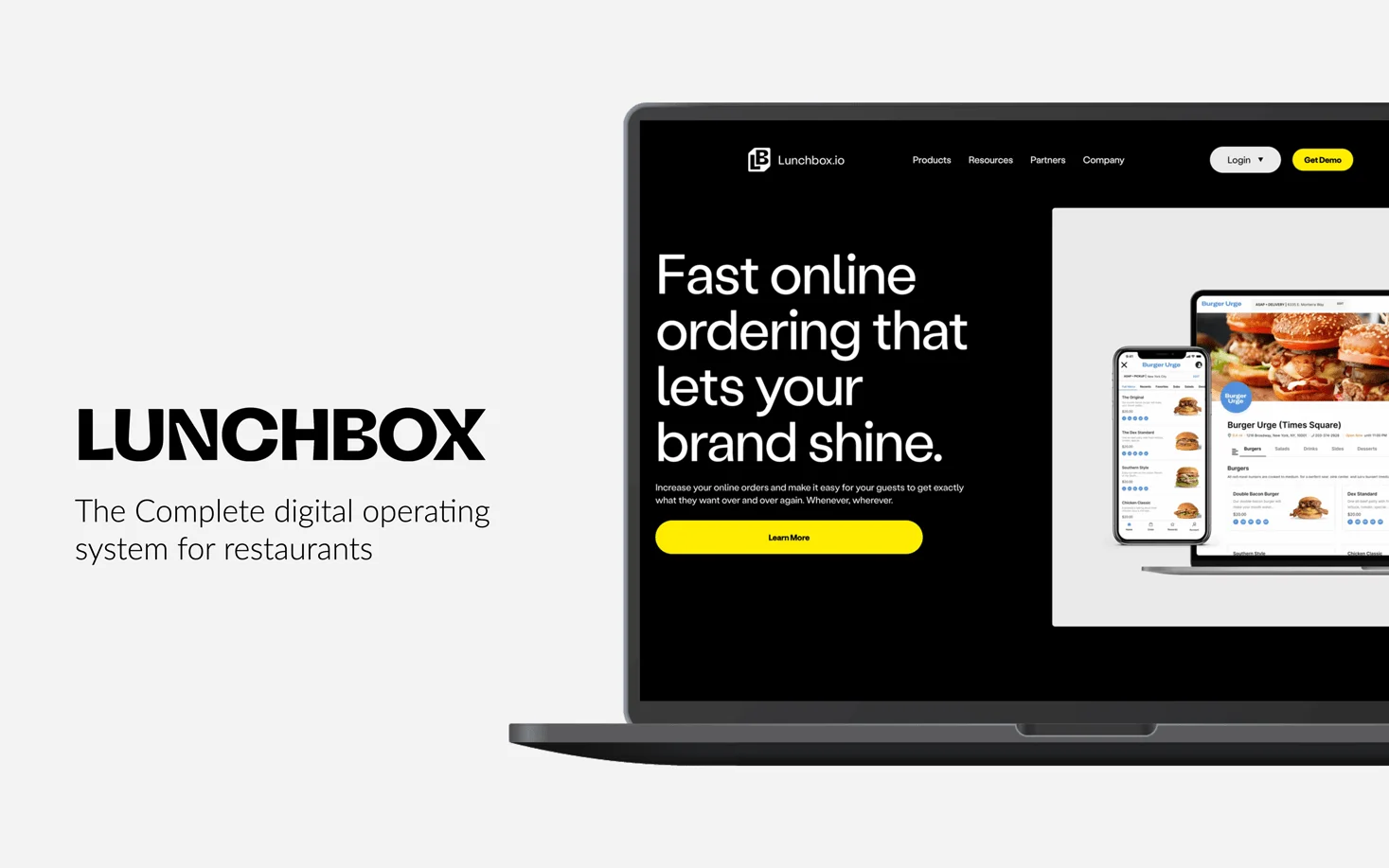
Lunchbox Pitch Deck Tear Down
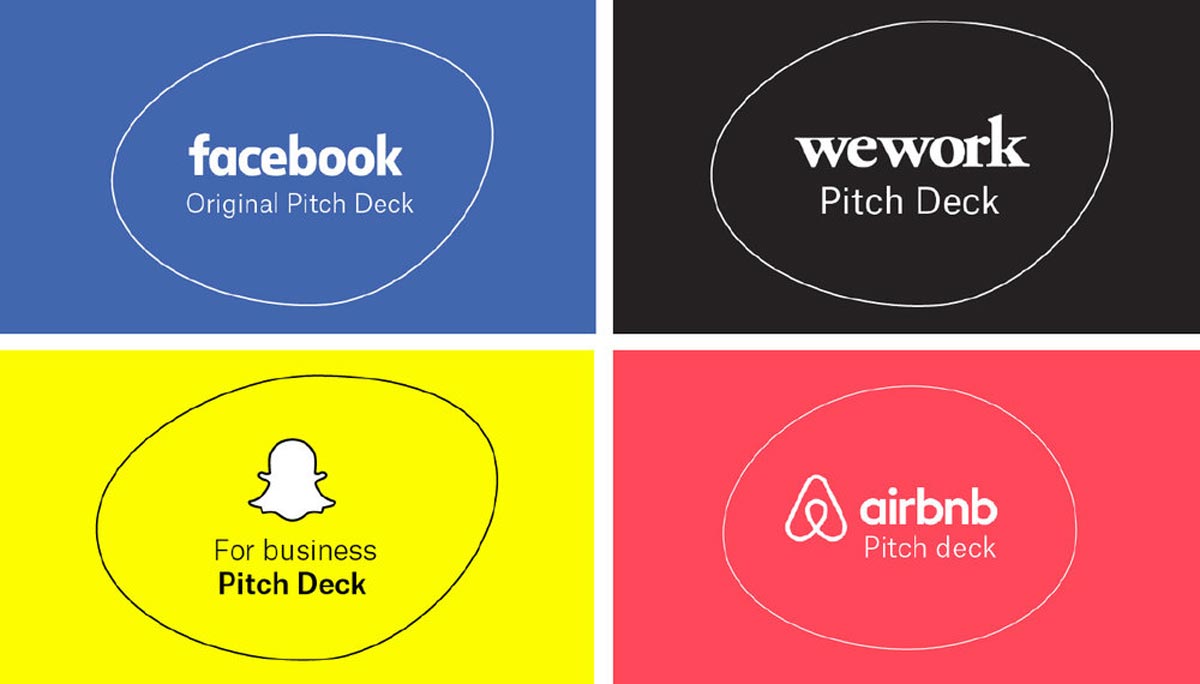
35+ Best Pitch Deck Examples from Successful Startups (2024 Update with Editable Templates Included)

Let’s move your company to the next stage 🚀
Ai pitch deck software, pitch deck services.

Financial Model Consulting for Startups 🚀

Raise money with our pitch deck writing and design service 🚀

The all-in-one pitch deck software 🚀

A pitch deck is the standard document used by startups to present their case to investors; it’s a brief deck of about 10 to 20 slides. See examples here.
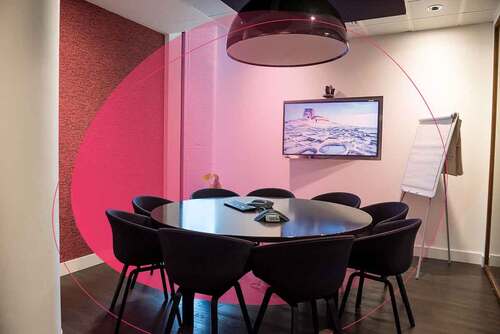
Learn how to create a compelling slide deck for your startup. Explore how to use slide decks as aids for your presentation, and the most common uses for them.

This is a functional model you can use to create your own formulas and project your potential business growth. Instructions on how to use it are on the front page.

Book a call with our sales team
In a hurry? Give us a call at

What is a Slide Deck? Everything You Need to Know!
By: Author Shrot Katewa

In my personal experience alone, I’ve seen people use very many different words including the word “Slide Deck” for a presentation. I always wondered what is the meaning of Slide Deck, and how is it different from other words commonly used to describe a presentation. So, I did a little research, and here’s what I found out!
A Slide Deck is a term assigned to a group of slides that together form a complete presentation. A slide deck is usually created using a presentation design application. A slide deck is often used as an aid for storytelling or presenting information about a topic or an organization.
But, how is a slide deck different from a slide show or a PowerPoint? In this article, we will understand the nuances of the various presentation terminologies used. Plus, I will also help you understand why is a slide deck really called a slide deck!
So, let’s get started.
A Quick Note Before We Begin – if you want to make jaw-dropping presentations, I would recommend using one of these Presentation Designs . The best part is – it is only $16.5 a month, but you get to download and use as many presentation designs as you like! I personally use it from time-to-time, and it makes my task of making beautiful presentations really quick and easy!
What is a Slide Deck?
When it comes to describing a presentation, there are several words that are used. One word that is often used is a “Slide Deck”.
As mentioned above, a slide deck really is a collection of slides put together to form a presentation. A slide deck is used in many organizations to give an overview about their organization, to share strategies or plans, or showcase performance updates, or even just sharing a piece of interesting information about a topic. There are several use cases for a slide deck!
You may wonder, “Is slide deck not just the same as a presentation?”. If so, then why not just call it a presentation instead of a slide deck? Why use the term slide deck at all?
Pro Tip: All slide decks are presentations, but not all presentations can be classified as a slide deck!
A presentation is usually a much broader term. For instance, when you are displaying a physical product and verbally sharing nuggets of information about that product, it is still referred to as a presentation. More specifically, it is called a product presentation.
The key difference between a slide deck and presentation is that a presentation is an act of delivering information such as a speech or a talk. Whereas, a slide deck is the visual aid used while giving a presentation!
Although the two terms are often used interchangeably, a slide deck and a presentation are actually two different terms!
Why is a Slide Deck called a Slide Deck? A Brief History!
The term slide deck evolved from an old technology that was used for projecting the slides on the wall. A physical 35 mm slide was inserted into a carousel slide projector . All the slides that were used during a presentation were collectively known as a slide deck (as in a deck of cards).

The term “slide deck” stuck around and became synonymous with a presentation even after the technology evolved . Thus, even today, many people refer to a presentation as a slide deck.
If you are wondering how this projector really worked, then you would be amazed to know that each model came with slots for 40 or 80 slides that could be inserted at a time.
Each slide would be placed upside down and backward in terms of the chronological order so that the image projected is in the correct orientation and order. The slide themselves were usually photographs and not much could be done on the slide.
Difference Between Slide Deck and Slide Show?
Another term that people often use interchangeably is a slide deck and a slide show.
A slide deck is the group of slides used to create a presentation. However, when these slides are displayed or shown to an audience while giving a presentation, the process is known as a slide show.
In other words, a slide deck is usually a presentation file whereas a slide show is a process of showing the contents of that file to an audience.
Slide Deck vs PowerPoint: What’s the Difference?
I’ve also seen people get confused between a slide deck and PowerPoint. Again, these are also another set of terms that are used interchangeably. But, there is a difference.
As mentioned before, a slide deck is usually a group of slides collectively put together to give a presentation. The term slide deck has existed even years before PowerPoint was introduced. As we learned above, a slide deck was initially used to describe the batch of physical slides used in a projector.
PowerPoint, on the other hand, is a presentation design software. Unlike a slide or a presentation, PowerPoint is actually a program that is used for designing a slide or creating a presentation.
As the technology evolved and a computer started to have more computing power, complex applications were designed to enable the ease of leveraging technology.
Contrary to the common opinion, PowerPoint was not created by Microsoft. It was first released by Forethought Inc in 1987 initially only for Mac OS. However, Microsoft acquired PowerPoint 3 months after its initial release and rebranded it as Microsoft PowerPoint.
What is the Difference Between Slide Deck and a Pitch Deck?
Another term that you may hear often, especially in the more recent times, is a pitch deck. It is important to note that using the two interchangeably might not be the correct thing to do. Here’s why –
A slide deck is basically all the final slides put together to create a presentation. However, a pitch deck is a type of a slide deck created with a very specific purpose of pitching an idea or a business model to an investor with the intention of raising funds for implementing the idea.
In this era of start-ups and entrepreneurs, a pitch deck is quite common. In fact, every time an organization is looking to raise funds for the project or business, a pitch deck is required.
Simply put, a pitch deck can also be called a slide deck, but not all slide decks can be referred to as a pitch deck!
What is a PowerPoint Slide Deck?
There are multiple ways of creating a slide deck. As we learned earlier, traditionally a slide deck was created using actual physical slides.
As the technology evolved, sophisticated computer applications were used to create a slide deck. One such application is Microsoft PowerPoint.
A PowerPoint slide deck is a term used to describe a slide deck or a presentation that is created using Microsoft PowerPoint as the presentation design application. A PowerPoint slide deck usually consists of multiple slides put together to create a presentation.
That said, a PowerPoint slide deck is more commonly referred to as a “slide deck” or just “Presentation” as PowerPoint is not the only presentation design application available to a user.
What is a Slide Deck in Google Slides?
Although PowerPoint has been one of the most well-known and commonly used presentation design programs, another application that has been gaining in popularity amongst the users is Google Slides!
The idea of a slide deck in Google Slides is pretty much the same. When you put together all the final slides that are going to be used in a presentation using Google Slides, it is known as a slide deck in Google Slides.
If you are not sure what exactly is Google Slides and would like to understand this a bit more in detail, I’ve written a detailed post on this topic. Make sure you check it out! Click on the below link.
What is Google Slides? The ULTIMATE Guide!
How to Make a Slide Deck in PowerPoint?
If you are using PowerPoint, one of the things that you may often be asked to do at work is to make a slide deck in PowerPoint. But, how exactly do you do that? Let me try to answer this question.
Here’s how to make a slide deck in PowerPoint –
- Open a PowerPoint Presentation
- Create a structure for your content
- Create a Title Slide
- Design the Other Remaining Slides
- Use Images relevant to the content
- Add Animations and Transitions
- Create a Thank You Slide
- Save Your Slide Deck
- Share the File with your team
Honestly, this topic deserves a separate article in itself. Perhaps even a single article may not be complete enough to cover this topic.
How to Make a Good Slide Deck?
Let’s face it – most of us don’t want to come across as incompetent. Thus, making a good slide deck is almost always important. But, how exactly does one do that?
There are actually several things that you can do to make an attractive presentation. I actually wrote a detailed article on how to easily create a good slide deck. The tips that I share in that article are also relevant for beginners. So, make sure you check out that article as well! The link is mentioned below.
7 EASY tips that ALWAYS make your PPT presentation attractive (even for beginners)
More Helpful Resources –
- Should You Add Table of Contents in your Presentation?
- How to Give a Presentation When You Are Not Prepared?
- A Quick Guide to Using Animations and Transitions in PowerPoint
Image Credit for the Featured Image
Home Blog Design How to Create a Slide Deck in PowerPoint
How to Create a Slide Deck in PowerPoint
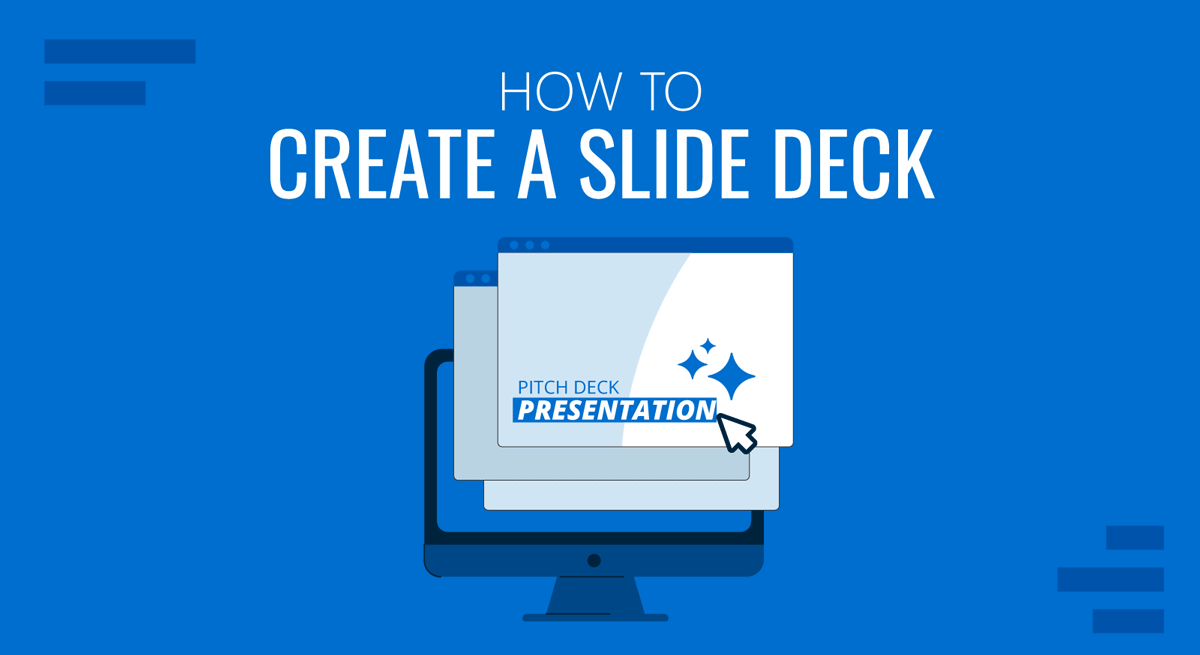
A commonly used term when working with presentations is “slide deck,” but what exactly do we mean by that? Should you be familiar with some core terms before making your first presentation?
As we believe continuous education is key for presenters, regardless of their presentation skill level, today, we will talk about presentation deck meaning, how to build a presentation deck, and which elements define success in this process. Additionally, for a broader understanding and skill enhancement in making effective presentations, our section on how to make a presentation offers valuable insights and practical tips. Without further ado, let’s get started!
Table of Contents
What is a Slide?
What is a slide deck, what should be included in a powerpoint slide deck, recommended slide decks for any kind of presentation.
A PowerPoint slide can be defined as a digital canvas in which we organize information and ideas in a visual format, primarily oriented for professional settings like business presentations, conferences, or academic presentations. People instantly associate slides with PowerPoint due to Microsoft PowerPoint being the industry-leading software in presentation software, offering full compatibility format with free software options like Google Slides.
The starting point of any slide is a blank canvas to which you can add a title, and you’ve got plenty of space to insert images, draw shapes, add videos to your presentations, and more. PowerPoint has a standard layout for its blank slides, as shown below. This layout can be modified by accessing Slide Master in PowerPoint .
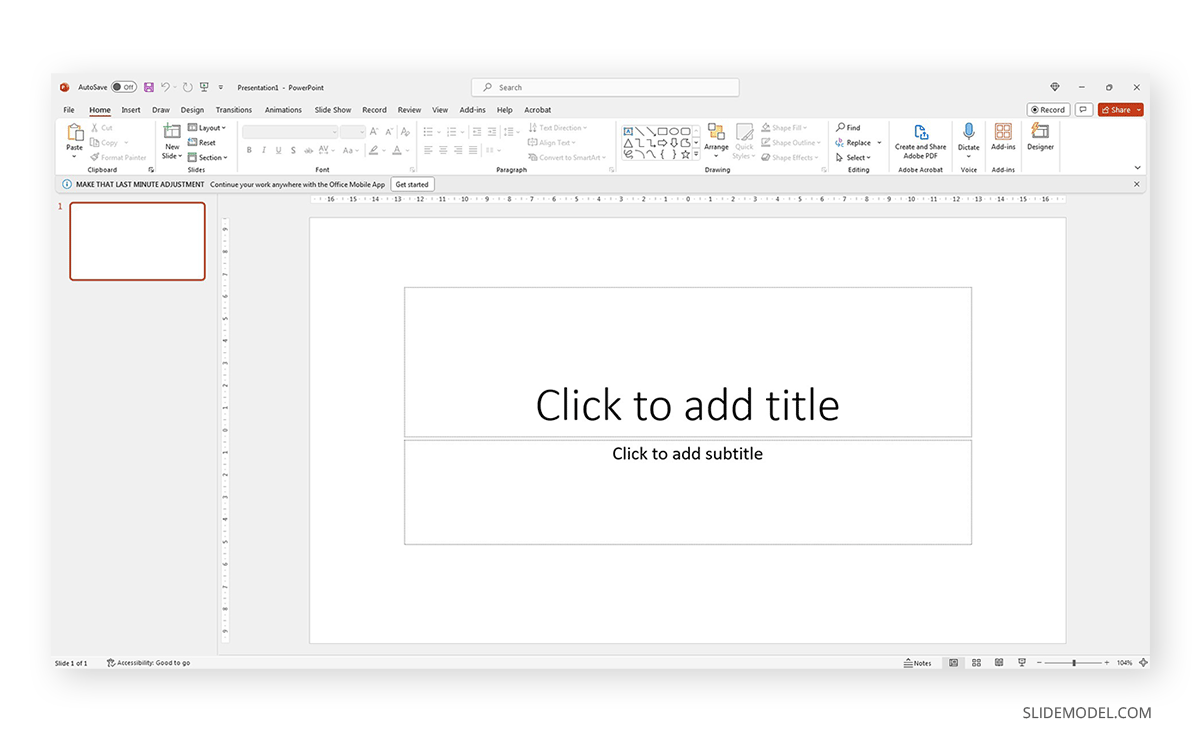
Each slide is a single page of a presentation and can be edited to meet the requirements of any presenter without meaning you alter the following slides. Remember, presentation software tends to work with destructive workflow methodologies – meaning the changes you make cannot be reverted if you save the file and try to access it later. If you want to test multiple design options on a single slide, we highly recommend you create individual slides for each design or even save them as different file names so you can revert to a previous stage without inconvenience.
A slide deck or PPT deck is a collection of slides curated for a sole purpose: serving as visual aids for a presentation topic. These slides can contain multiple tools like charts and graphs , placeholder text areas, icons, dashboard display, illustrations (in the format of vector images), and way more depending on three key elements:
- Build quality: How much effort the creator put into crafting the slides.
- Software: Although compatible, PowerPoint decks may offer some effects that aren’t available in Google Slides. For that reason, creators often flag animated slides or slide decks containing complex shadow effects as only PowerPoint-compatible.
- Topic: A presentation deck intended to present a marketing plan won’t contain the same elements as one intended to deliver a motivational talk.
Before deciding how to start a presentation , select a slide deck compatible with the topic your presentation is geared toward.
We like to work with the method of using one topic per slide. This means not overpopulating your slides with content for the sake of showing content. Such practices affect readability and the overall understanding of your presentation.
Instead, we will teach you how to curate content in your slide decks by taking pitch deck templates as an example.
Say we select the Executive Pitch Deck PowerPoint Template . This pitch deck is intended to introduce potential investors to what the business is about.
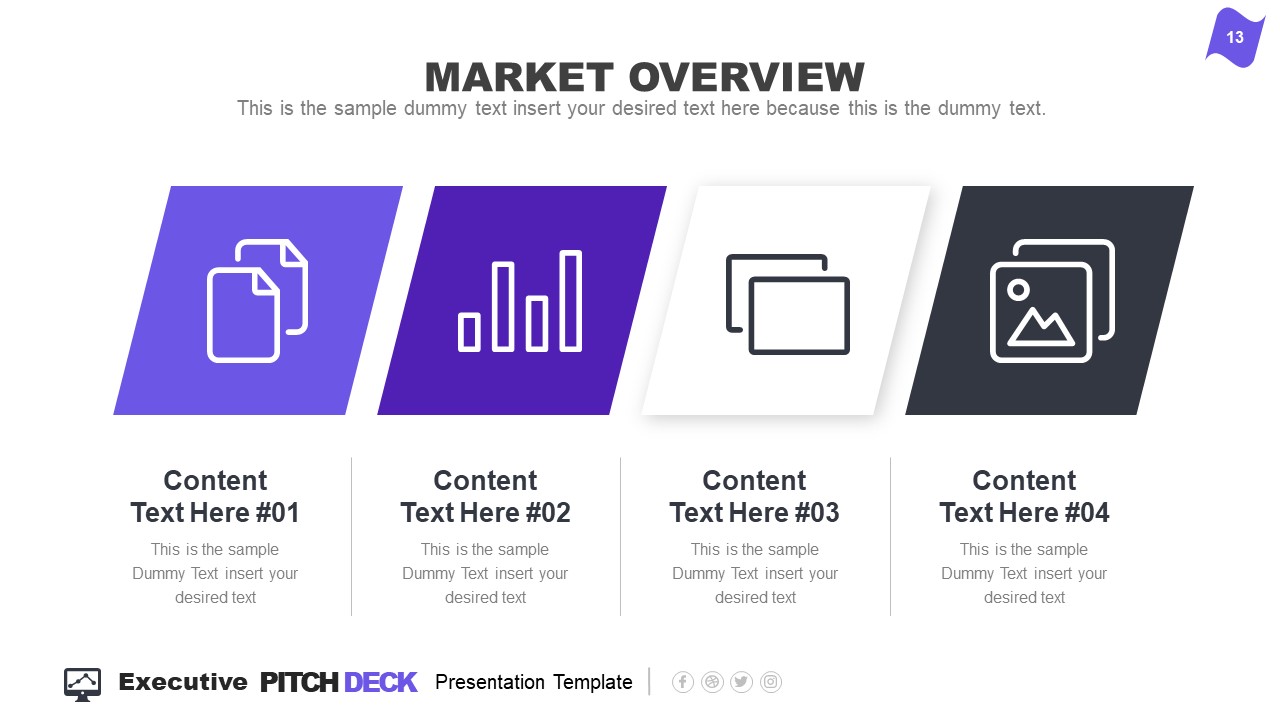
Rather than filling all the data in just 2-3 slides, take it easy and work with the layout this template offers:
- Title Slide: Every single presentation should list a title slide, with quality graphics and the presentation title being clear enough. Additional information can include the presenter’s name, the company’s name, logo, etc.
- About Us Slide: In business environments, companies should always introduce themselves, highlighting key information like the industry they move in, significant milestones, etc. Remember, this is an introduction to the company as an entity, not a description of your team members.
- Best Services: Depending on your niche, take this as an opportunity to promote your core activities as a company.
- What We Do: This is complementary to “Best Services.” It is the section where you specify which areas your company covers and why your services stand out against competitors.
- Mission and Vision: Required for any pitch deck presentation.
- Meet the Team: This slide can either be an org chart or be presented through photos for the managers per department (the interaction points between stakeholders and management).
- Our Advantages: Ideal to complement slides 3 and 4, this expresses the competitive advantage of the company and marketing plan, and you should present your flagship product or service.
- Market Opportunity: What led your company to approach its niche, attending to customers’ pain points.
- Timeline: This slide serves to introduce significant milestones, projects, planned strategies, deadlines, etc.
- Market Size: When we have to answer the total addressable market (TAM), we can use a slide representing TAM, SAM, and SOM .
- Competitors: Two slides in this presentation deck talk about a company’s competitors and different approaches to representing that data with visual impact.
- Data Chart: If you intend to discuss a KPI in particular, this chart slide can work to expand the talk over that point.
- Product and Demo: This works either for e-commerce or physical products. Presenters can alter the slide to discuss services rather than products or just keep the “Best Services” slide.
- Pricing Slide: When discussing a business pitch, you must present your current pricing range to potential investors. In this case, the slide resembles the pricing tier format you can find on many websites.
- Thank You Slide: Knowing how to end a presentation with class is critical to securing a business deal. You can include a photo that resembles closing a business deal, a video that further expands your company’s history, products/services, and culture, or leave it with a minimalistic “thank you.”
With just 15 slides, you can create a powerful slide deck communicating your message to your target audience. Keeping a clean layout and following the 1 topic per slide rule ensures your presentation delivers a clean speech.
Now, we’ll move on to how to make a presentation deck from scratch. We recommend working with PowerPoint Templates , as design decisions are already taken for you (font pairing, color schemes, placeholder areas, balance between text and graphs).
Select a Slide Deck
By browsing professional PPT template creators’ websites like SlideModel, you can find a vast selection of products tailored to your needs. It is as easy as to browse for the topic you want via the search bar, locate a product you desire, and download it to your account. You can also explore the available products per category through menu elements.
Insert your Content
Every single presentation deck available at SlideModel.com is entirely customizable. We can add illustrations by going to Insert > Picture and selecting the origin from which you want to upload your image into the presentation.
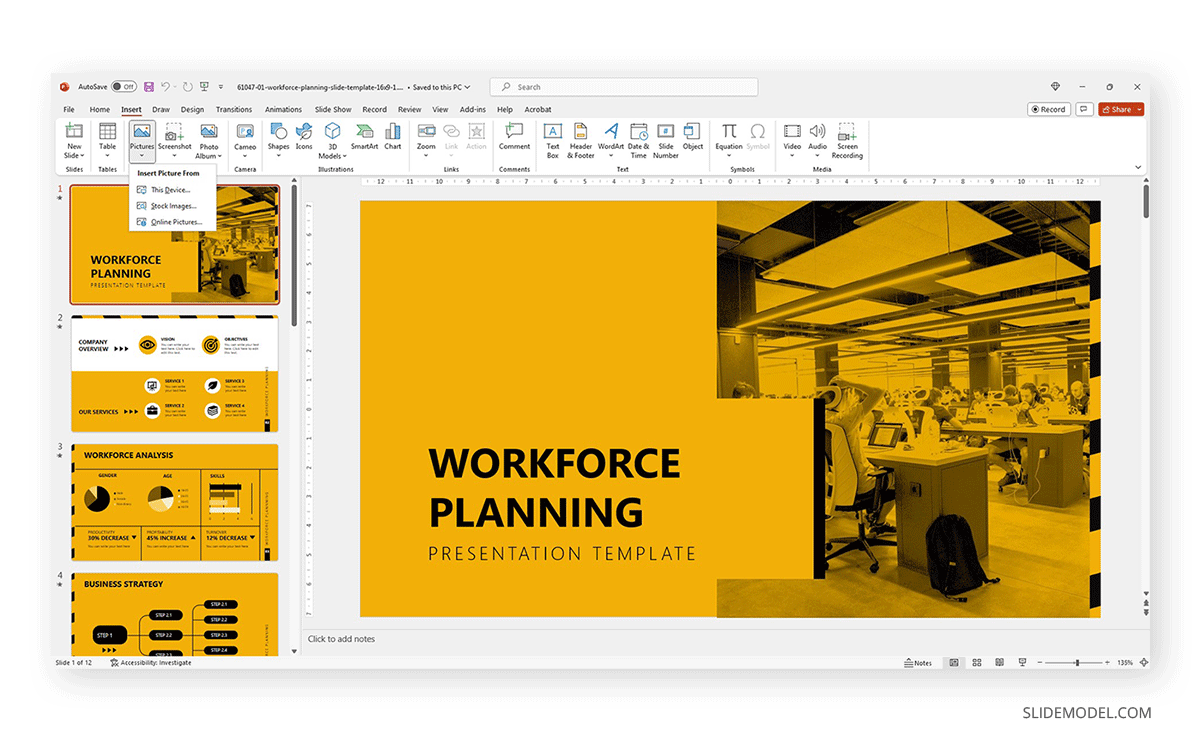
Also, users can customize the template and replace the image in the placeholder area by right-clicking over it and selecting Change Picture .
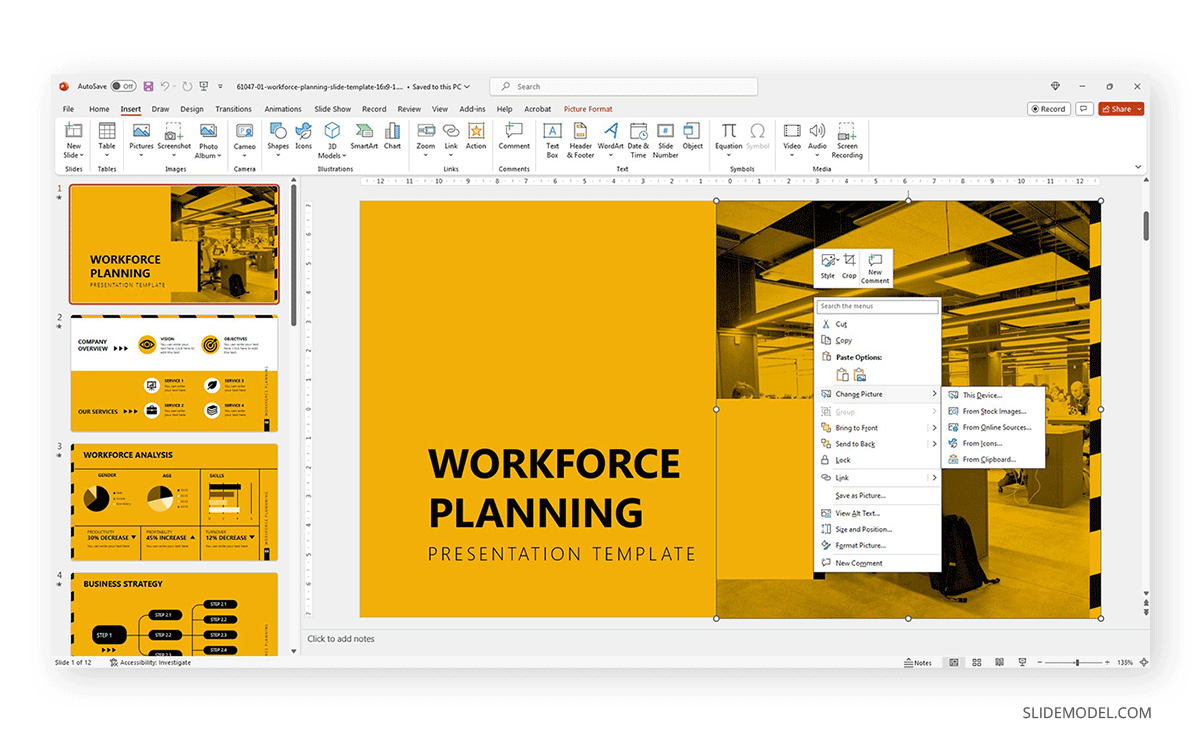
Text content can be edited in the text placeholder areas by clicking over it. Charts and graphs may require some extra steps depending on how they were crafted. To replace the placeholder data, simply select the chart or graph element and click on the Filter option next to it. Seek the Select Data option at the end of the contextual menu.
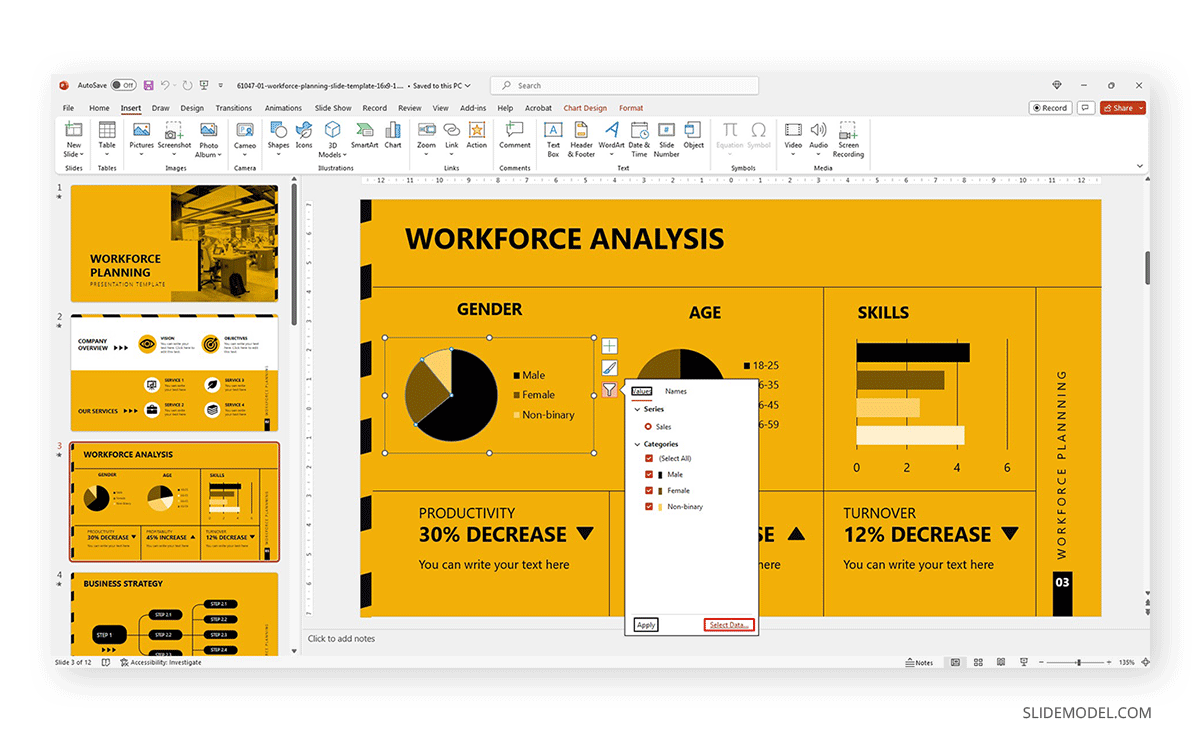
Modify the data used as a sample in the chart with the information pertinent to your company or project. An MS Excel spreadsheet will open up to allow that procedure.
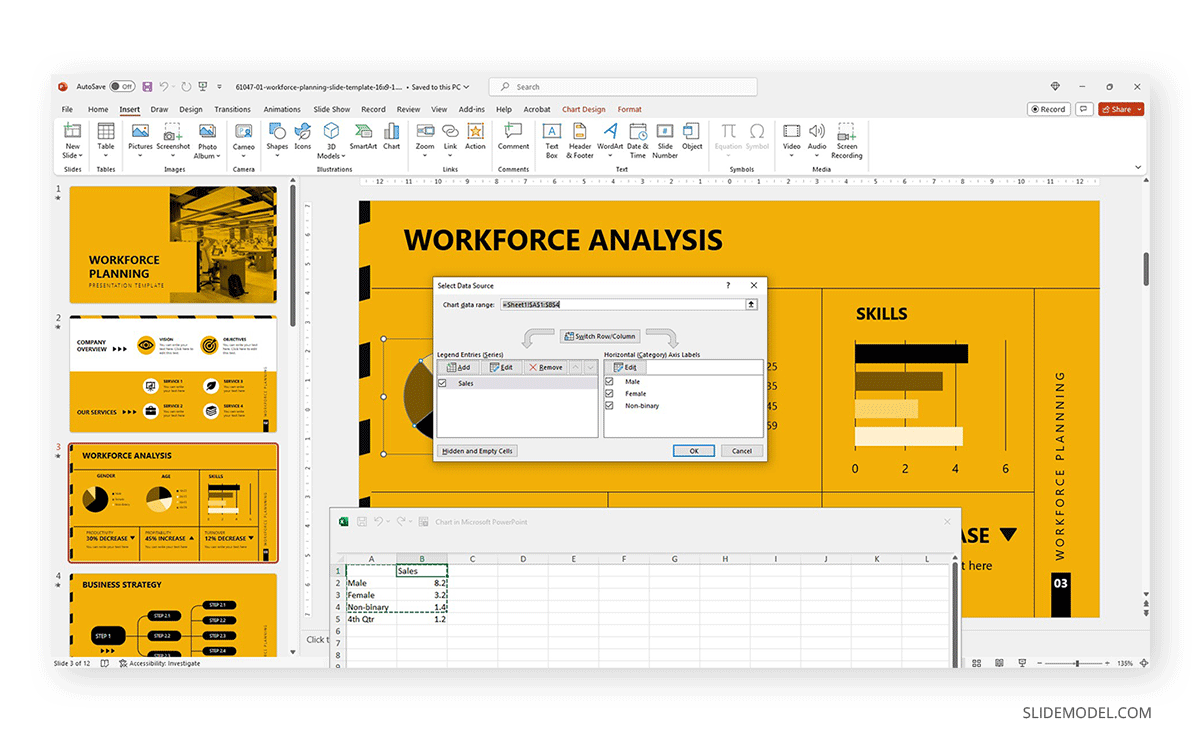
Other Customization Options for Slide Decks
Finally, we recommend you check the following articles to learn more about aspects to edit in slide decks:
- How to change fonts in Slide Decks .
- How to change the theme in Slide Decks .
- Which fonts will make your Slide Deck stand out .
- How to insert 3D models in Slide Decks .
- How to change slide layout in a Slide Deck .
- How to rotate a slide in PowerPoint .
What are the key elements of an effective slide deck?
A clear and cohesive theme, concise and impactful text, and high-quality graphics are all you need to create a powerful slide deck, as long as it follows a logical flow that guides the audience through the presentation.
Can I create a slide deck if I don’t have Microsoft PowerPoint?
Yes, our expertise in this field tells us there are no visible differences between working with PowerPoint and Google Slides or Apple Keynote to create a quality presentation, except for some curved text effects and complex animations.
What are some tips for choosing a theme or template for my slide deck?
- Select a theme or template that aligns with the presentation’s topic or audience.
- Consider the context and setting of the presentation.
- Opt for a clean and professional design that backs up your speech rather than add distracting elements.
How can I add and format text on my slides?
When working with presentation software, you can format text as you would work with any text editor. Remember to stick to concise and clear language, with no technical jargon. Huge “text walls” deter the audience from your talk, as there’s a natural impulse to read the content. Opt for legible fonts rather than complex script typefaces.
How can I ensure my slides are consistent regarding fonts, colors, and styles?
Using a consistent color scheme is the first step, which can be analogous (easier to work), complementary, or bolder options as long as you stick to recommended color pairings. Avoid harsh contrasts, as they make your slides less legible. Use a maximum of 3 different fonts in your slide, best if 2 only.
1. Innovative Business Presentation Template Slide Deck

Powerful graphics with contrasting tones that add a vibrant vibe to your presentation. This slide deck is ideal for startups, tech talks, or any presentation that wants to showcase a vanguard style in touch with the latest design trends.
Use This Template
2. PPT Slide Deck Template
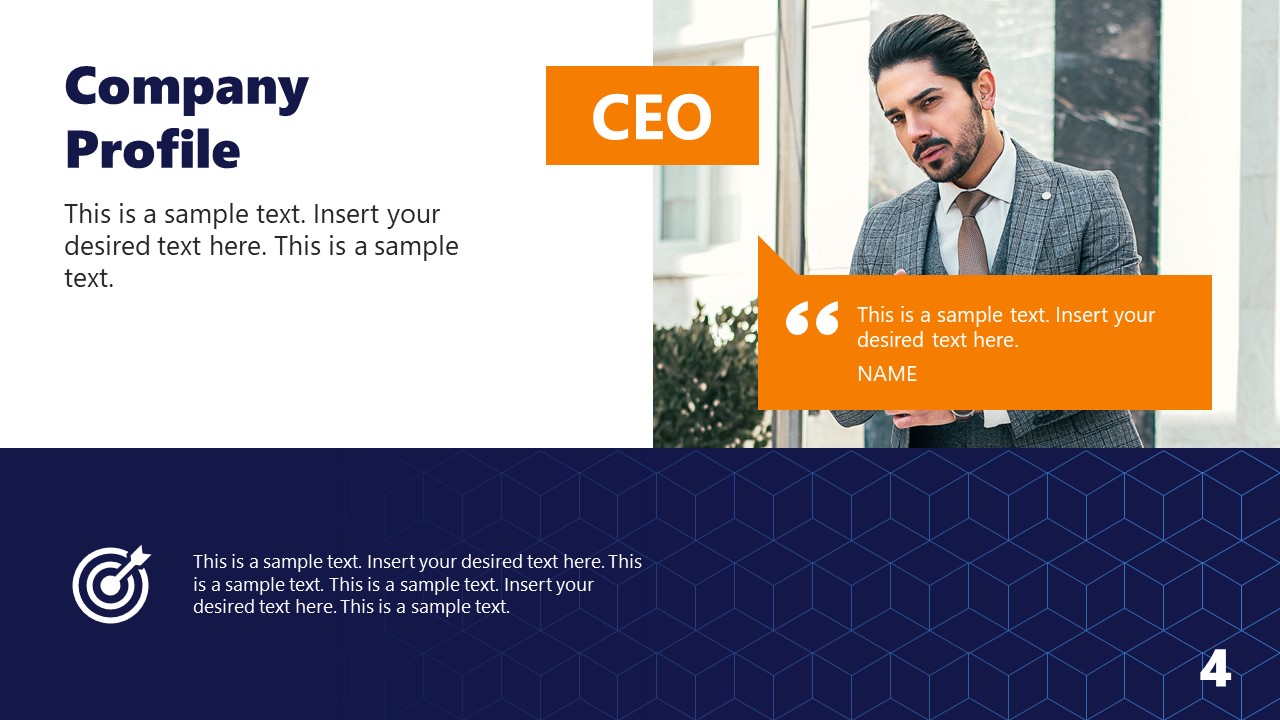
A semi-formal slide deck that balances many visual aids and placeholder text areas while bearing a complementary color scheme. Ideal for team meetings, introducing your company to investors, or academic presentations.
3. Business Executive Presentation Deck for PowerPoint
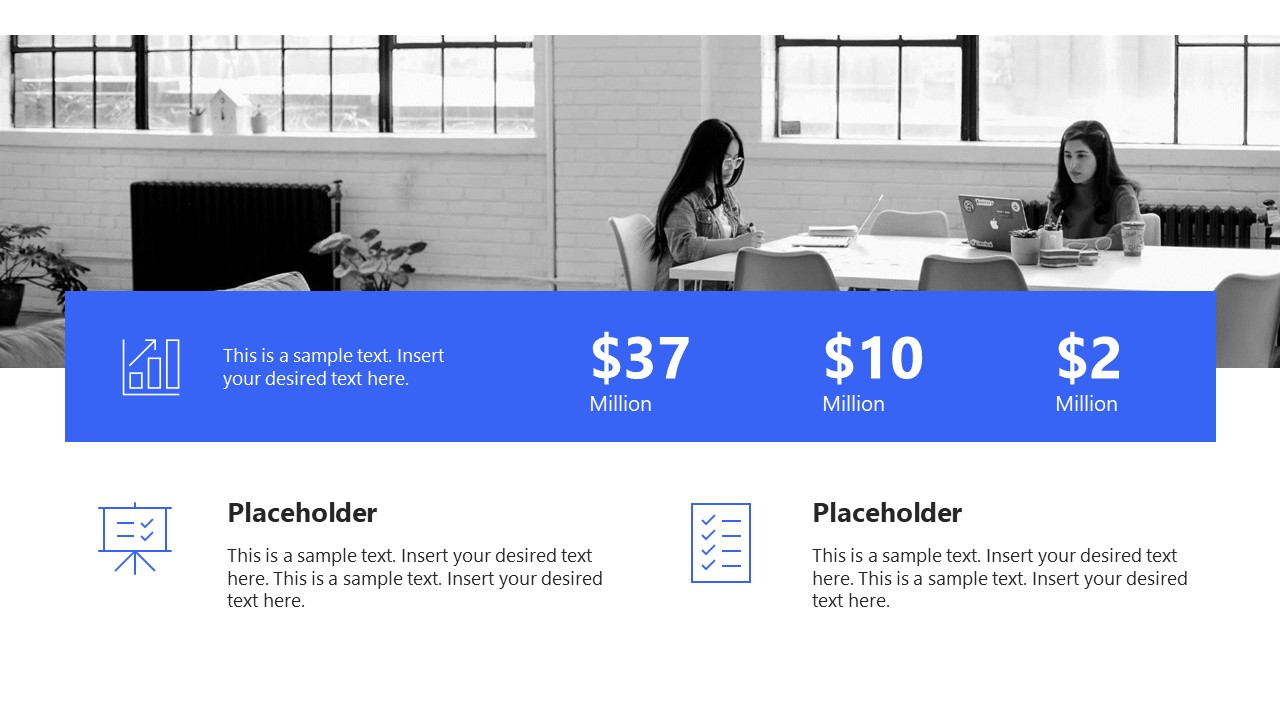
Sleek, formal, and with plenty of tools to repurpose this slide deck for multiple presentation requirements. A fully editable PPT presentation deck that can accommodate an alternative theme to its distinctive cool blue executive tones.
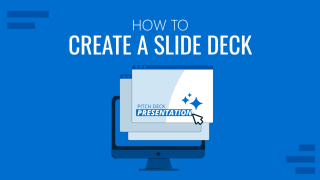
Like this article? Please share
Design, Microsoft PowerPoint, Slides Filed under Design , PowerPoint Tutorials
Related Articles
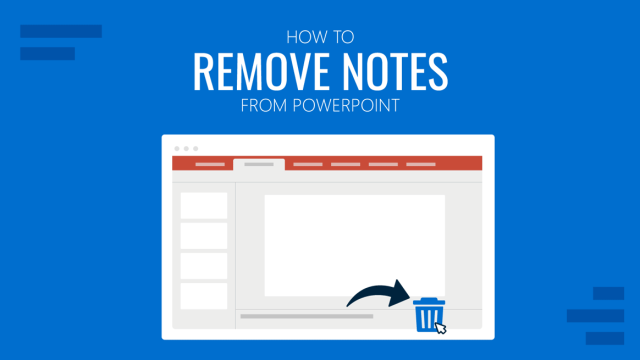
Filed under PowerPoint Tutorials • April 9th, 2024
How to Remove Notes from PowerPoint
Make alternative versions of your presentation files by learning how to remove notes from PowerPoint. Step-by-step guide with screeshots.
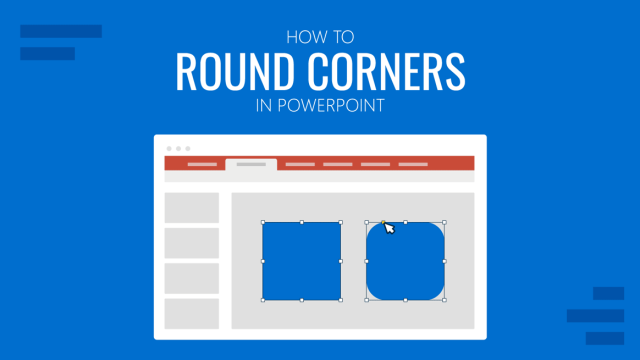
Filed under PowerPoint Tutorials • April 2nd, 2024
How to Round Corners in PowerPoint
Learn how to add rounded corners to shapes and images in PowerPoint. Elevate your presentations with sleek designs. Expert tips and step-by-step guides.

Filed under PowerPoint Tutorials • March 26th, 2024
How to Translate in PowerPoint
Unlock the experience of PowerPoint translation! Learn methods, tools, and expert tips for smooth Spanish conversions. Make your presentations global.
Leave a Reply
A guide to creating great decks and presentations

At some point in your creative career, chances are, you’ll have to make some kind of deck. Used as a key communication tool in many creative roles, decks convey ideas through a carefully selected sequence of words and images. A great deck can help you explain a brilliant idea, tell a powerful story, or sell your skills and experience in one neat little package. While it can seem like a lot to balance, the process of putting one together needn’t be tricky. We take you through all the steps to create a fail-proof one.
What’s the difference between a deck and presentation?
A deck is simply a set of digital slides containing images and words, used to get across an idea. You’ll often need to make a deck when you want to persuade someone to think about something in a certain way.
A presentation is a form of communication that tells a story or expresses an idea. A presentation can include a deck, but it can also be delivered as a video, audio file, or as a speech.
You can give a presentation without a deck (for example, a Ted Talk with no visuals) and you can send a deck without having to present it (for example, sending a PDF update of a project with written notes).
Typically, a deck is:
The visual component of a presentation, without any spoken dialogue
A digital file made using the software of your choice
Presented in landscape format
Decks can be designed for the following purposes:
To be presented in person, as part of a meeting – via a laptop or TV screen
To be presented virtually, for example via Zoom, Google Meet or Microsoft Teams
To be viewed in the form of a PDF sent over email, as a live link or a downloaded file
When will you need to make one?
Depending on where you’re at in your career, you might need to make decks for different purposes. These could include:
Creating a presentation as part of a job interview task
Pitching and presenting ideas in response to a brief
Creating briefs, treatments or presenting research
Informal purposes, such as to introduce yourself at a new job
What does a deck look like?
The work of deck-making is often done behind the scenes in a studio, and for copyright or competition-related reasons, creative development decks are often kept under lock and key. 🚨 This means that great examples of decks are not easy to find online!
That being said, as soon as you start working alongside other creative people on projects, you’ll likely have a chance to check out their approach. If you’re part of a studio, you can usually check out their previous decks. And if you’re a freelancer, you could ask more established freelancers to talk you through some of their decks – it never hurts to ask!
Ultimately, the look and feel of a deck will differ depending on what it’ll be used for. You can see great examples of presentations and decks during online or in-person talks; some good examples are Nicer Tuesdays or the First Round conference, in which creative leaders talk through their work-in-progress visual identity decks.
What goes into a deck?
The slides needed for a deck will differ depending on what it’ll be used for; you might need less for a short introductory talk about yourself, and more for an in-depth pitch to a client.
Generally speaking, most decks will include a combination of some (or all) of the following slides:
Contents page
Title pages to signpost different sections
Project slides to support different combinations of images, text or moving image
Conclusion page to detail any next steps
Final page with contact details

What makes a great deck?
In a nutshell, a great deck should be:
Clear, concise and cohesive
Specific to and engaging for your audience or reader
Supporting the story you want to tell
Carefully checked for accuracy, spelling and image quality
A lot of the things that make a deck successful also apply to making great portfolios. You can find all sorts of transferable learnings and relevant advice in our guide to creating your PDF portfolio .
Before you begin: Planning your presentation
Before you start choosing colour palettes and flicking through font choices, there are some essential considerations to keep in mind:
🤔 Who is your audience? What do they need to know?
Are you pitching new ideas to a client, or updating your co-workers on a project’s process? Knowing the purpose of your deck will inform your structure, design and layout. For example, a client pitch will require you to strike a different visual tone to a catch-up with your team.
Think about the size and location of your audience. How might your approach differ for a big or small group, or whether you’ll be presenting it online or IRL?
⏰ How long will you have to present?
Knowing your exact timeframe will help you gauge the scale of your deck, how many slides you might need and how in-depth you can go with the details. While informal presentations to your co-workers may be more relaxed, running over with clients is not always an option, so be strict.
If you have a short amount of time, prioritise need-to-know info and get quickly into what you want feedback or input on. If you have more time, you can build your story gradually.
🤝 Are you working collaboratively or alone?
If you’re working on a deck as part of a team, you may want to delegate tasks. For example, one person could prepare the images while another writes the text. But remember: the text will always need to relate to the images (and vice versa) so make sure both collaborators cross-reference regularly.
If you’re presenting as a team, are you taking turns to speak? You’ll need to agree on who will be presenting each section. You can find more tips and tricks on preparing for presentations in our guide to public speaking .
How to create a structure that tells a story
Your deck needs to tell a story – whether that‘s guiding someone through different creative ideas, or taking a viewer on a journey from one point to another.
It’s vital to work out how you will explain and unpack your idea or project through your deck, as the right structure will ultimately determine how successfully your story comes across.
🕸️ Join the dots between your points
To start, write down everything you need to cover during the presentation. Create a list of talking points before beginning to build the slides or delving into image research.
Once you’ve worked out the key content to include, think about the best order in which to communicate this. Think of it as a linear process: you need to get from A to B in the clearest, most logical way.
🏁 Start and end well
The first slide of your deck should be as strong as the last. If you’re sending the deck by itself, ensure you summarise the contents at the start, and if you’re presenting, remind everyone of the purpose of the meeting so that your audience understands what you’re going to cover and what is being asked of them.
You might want to end the main section of your presentation with a memorable image, some well-chosen closing words, or a call to action inviting your audience to do something like approve a project budget, or select a creative idea for further development.
The final slides in your deck should include a short summary of what’s been covered and an outline of next steps. Don’t forget to include contact details in case the deck gets passed around.
Presenting a solution to a creative brief? This is one way of laying it out:
Title slide
Contents page: be sure to match your section titles to this
The brief or challenge: what is the specific request you’ve been asked to respond to, or what you were hoping to solve?
Starting points or initial inspiration
Your final idea(s), solutions or offerings: this can also include any alternatives
Timelines or additional information: this could include information regarding other collaborators or budgets
Conclusion or summary: a chance to reiterate the main points covered
Next steps or milestones in the process
If you’re attending a job interview or have been asked to prepare an introduction to your work – your deck structure might look like this:
- Title slide: this can include your name and role, along with a personalised greeting or message for your audience, like “Hi [name of studio], nice to meet you!”
- Contents page: you may want to skip this if you only have a few sections.
- Your background in a nutshell: this can be a short, personal statement that highlights your specific skills and interests. Don’t forget to inject some personality — this deck is meant to be about you, after all!
- Your work: only include projects that feel relevant to your audience. You might want to divide this section into several mini-sections if you have different types of work to showcase.
- Final page with contact details: let people know where they can reach you, whether that’s via email or on a social media platform.
How should you design a deck?
The way in which you combine visuals and text on slides can play a major role in how successfully you communicate your story. Remember, every image and word needs to earn the right to be included.
It can be useful to start by sketching out your rough layouts for your slides to visualise the main elements you need to cover.
🏡 Try out templates, or create your own
If you’re working in-house, there’ll likely already be set templates to follow or use as a starting point. Ask your colleagues to share different types of presentations, and familiarise yourself with the house style. If you’re a freelancer, it may be worth setting up a template using the same typefaces, layouts and colour palettes so that you can create some consistency across your decks. It will save you time in the future and bring a level of professionalism to your presentations.
Remember that a template should help you, not constrain you. Use one as an overall guide, but adjust according to the specific content you want to include — and give yourself room to play.
🔁 Consistency is key
Whether you’re following a preexisting template or setting up your own, consistency is key to putting together a cohesive deck. This is an opportunity to create system of rules that will provide you with a reliable and flexible structure, regardless of the kind of deck you need to put together.
Establishing a consistent visual language allows you to focus on telling the story at hand, rather than having to re-design your slides every time – and also helps an audience or viewer to follow your thought process. All your slides should feel like they belong to the same visual world. Here are a few key elements to consider:
- Grid, layout and treatment of images
- Colour palette
- Typefaces and treatment of text (choose one size for section headers, one for headlines, one for body copy or bullet points
💥 Create impact with your images
How might you create visual impact with your images? For example if there is a particularly strong visual that helps support the narrative of your presentation, why not make it full bleed to grab your viewer’s attention?
Or if you have a selection of images to share, think about what layout will help convey a variety of options without looking too cluttered. Remember that images should be captioned where necessary – describing to viewers what they’re seeing – without over-explaining.
Ensure your images have a high enough resolution that they look sharp, but not so large that they take ages to load! Exporting images as PNG files can be more reliable than JPEGs in terms of consistent quality.

👾 Know where it’s relevant to use GIFs
Videos or GIFs can be a great addition to a deck. If you have a shorter amount of time to present, a piece of moving image can quickly set the tone – whether poignant or humorous. They usually require less explanation than a still image, and the audience can watch clips and GIFs while the presenter is speaking.
In a longer presentation, you may be able to include a full-length video that will form a distinct chapter in the deck.
🔠 Be selective about how much text you include
The amount of text you use will depend on whether you’ll be talking through the deck, or sending it as a link or attachment for your audience to read in their own time. Think: how are you presenting?
As part of a meeting You may want to use less text in your slides (no one can read and listen at the same time). The fewer words on screen, the stronger the visual effect and overall impact.
Remember that if you’re presenting your deck to an audience, depending on the platform you use, you could always use speaker notes (additional details that no one else will see on screen) with additional information to elaborate on certain points or offer additional detail. This can also be a great tool to help you remember your cues.
Sending via email You might want to include more text on your slides so that the reader has all the information they need to understand the story without you there.
With all that said, be wary of where you place your text – avoid adding your copy over busy images or backgrounds to ensure everything is easily legible and to create maximum impact.

🌍 Opt for accessible typefaces
Choose a typeface that’s easy to read, and easily accessible – regardless of whether you’re presenting it from your laptop or sending it over email. You don’t want to spend hours designing your slides only for your text to appear in a default typeface later on. Have a look at our article to find a range of free fonts and typefaces for inspiration.
Once you’ve made your selection(s), ensure your text is large enough for people to read on a screen – whether in person or online.
🔺 Consider information hierarchy
A list may be easier to digest than a paragraph. Using a combination of the below can help make your content more digestible:
- Subheadings
- Bullet points
- Image captions
🚪 Use page furniture
This is information that consistently sits at the top or bottom of a slide. It can be a useful way of presenting information such as the date, project title, slide number and section title.
What can you use to actually build a deck?
How you make your deck depends on how your audience is going to receive it. Will you be presenting in person or online? Or do you need to send it via email?
There are a wide variety of deck-building platforms to choose from. Below are some of the main players. You can find more in our article on platforms and programs to make decks on .
Google Slides
Adobe InDesign (then export as a PDF)
Presented (service)
You could also use a mixture of these. If you’re creating your deck as a team effort, Google Slides or Pitch allows for seamless collaborative working and is easy to share as a link to a live file. Or you could use InDesign and then export the slides as a PDF, or individual jpegs to be dropped into another program.
You now have everything you need to go out and make amazing decks. Creating these takes practice, so don’t worry if you don’t nail it the first time. As you develop your deck-making skills, you’ll find a style you gravitate towards. Now go out there and dazzle the room with your sparkling slides!
With special thanks to Philippa Leguen de Lacroix, Director, Presented
Written by Creative Lives in Progress
Related Content
A guide to creating your portfolio website, a guide to networking and making connections.

The best creative advice from our 2023 Creative Lives

We use cookies on Creative Lives in Progress to analyse and measure activity across the website.
INKLUSIVE* Blogs

What is a Presentation Deck? Everything About Different Presentations
- By Aayush Jain
- Posted December 14, 2023
- in Presentations
Imagine walking into a room, ready to impress an audience with your ideas. That’s where a Presentation Deck comes in – it’s your secret weapon for storytelling and persuasion. Whether you’re pitching an idea, sharing insights, or educating a crowd, think of it as a collection of slides. There are a variety of presentation decks that cater to every scenario, from corporate pitches to educational lectures to creative showcases, all designed to engage, inform, and inspire. This is the world of presentation decks, where every slide has the potential to make a lasting impression!
What is a Presentation Deck?
You use a Presentation Deck to share information, ideas, or data visually. It’s a digital storytelling tool you use in the workplace and in school. Using this deck, complex information becomes easier to understand because every slide works together to form a cohesive narrative.
Significance of a Presentation Deck
An effective presentation deck transforms concepts into visuals. It’s not just about displaying data, it’s about telling a story that connects with people. A well-crafted deck can make presentations more effective by highlighting key points, supporting spoken words with visual aids, and keeping the audience engaged.
The Role of a Presentation Deck in Business Communication
You can use a presentation deck to pitch ideas to investors, share annual reports with stakeholders, train employees, or share strategies with your team. The deck is crucial for communicating business goals and strategies clearly and persuasively, so it’s an important tool for making decisions, sharing info, and influencing people.
Difference Between a Pitch Deck and an Investor Deck
- Pitch Deck: This is your business’s first impression. It’s a concise, engaging presentation used primarily for initial meetings. Rather than focusing on the nitty-gritty details of your business model or product, you should focus on capturing attention and creating excitement.
- Investor Deck: The investor deck comes after you’ve captured investors’ interest. It’s a detailed presentation that goes over the details of your business plan. It’s got financials, market analysis, growth strategy, and a long-term vision for your company. Using it, you’ll give potential investors a complete picture of your business, so they’ll be able to make informed decisions.
Features of a Pitch Deck
A pitch deck is a concise presentation used by entrepreneurs to provide their audience, typically potential investors, with a quick overview of their business plan. Here are the key features that should be included in a pitch deck:
Engaging and Story-driven
Your pitch deck should not just present facts but tell a compelling story about your business. This involves weaving a narrative that covers where your business started, where it is now, and where you see it going.The story should be relatable, capturing the struggles, successes, and aspirations of your business. This approach helps create an emotional connection with your audience, making them more invested in your idea.
Simple and Clear
Clarity is crucial in a pitch deck. The information should be presented in a straightforward and easily digestible manner. Avoid industry jargon or overly technical language unless necessary. Each slide should focus on one main idea, ensuring that your audience can quickly grasp your points without feeling overwhelmed.
Attractive Visuals
The design of your pitch deck plays a significant role in maintaining the audience’s attention. Use high-quality visuals and ensure that the design is consistent throughout the deck. This includes using a harmonious color scheme, readable fonts, and clear, impactful images or graphics. The visual elements should complement and reinforce the narrative, not distract from it.
Solution-Focused
Clearly articulate the problem your business aims to solve and why this problem is significant. Then, demonstrate how your product or service provides a unique and effective solution. This section should highlight the benefits and value your business brings, making it clear why your solution stands out in the market.
Highlighting Key Business Aspects
Your pitch deck should succinctly cover critical aspects of your business. This includes:
- Business Model : Explain how your business makes money. Include your pricing strategy, revenue streams, and any unique aspects of your business operations.
- Target Market: Define your target audience. Include demographics, psychographics, and any relevant behaviors or trends that make them an ideal customer for your product or service.
- Competitive Advantage: Discuss what sets your business apart from competitors. This could be your technology, team expertise, partnerships, proprietary data, or any other unique strengths.
Financial Projections
Present realistic financial projections that show potential growth and profitability. If you’re seeking funding, be clear about how much you need, what you will use it for, and what investors will get in return.
Call to Action
End with a clear call to action. Whether you’re seeking funding, partnerships, or just looking to build connections, be explicit about what you want from your audience following the presentation.
What Makes an Investor Deck Stand Out?
An outstanding Investor Deck not only informs but also impresses potential investors by demonstrating a deep understanding of your business and its place in the market. Here’s a look at the elements that make an Investor Deck stand out:
Detailed Financials
- Present comprehensive financial data, including historical revenues, profits, and cash flow if applicable.
- Include detailed projections for the next 3-5 years, showing expected growth and scalability.
- Break down your use of funds, specifying how you plan to allocate investment capital.
- Financial metrics should be realistic, well-researched, and based on sound assumptions.
Market Analysis:
- Conduct an in-depth analysis of your target market, including size, growth rate, demographics, and behavior patterns.
- Discuss market trends, and how your business is positioned to capitalize on these trends.
- Perform a thorough competitive analysis, showcasing your understanding of your competitors and your business’s unique positioning.
- Highlight any market research or validation that supports your business model.
Growth Strategy:
- Clearly articulate your strategy for growth, explaining how you plan to acquire and retain customers .
- Detail your roadmap for scaling operations, including any expansions into new markets or product lines.
- Discuss marketing strategies and sales channels you’ll use to drive growth.
- Show how your growth strategy aligns with industry trends and market demands.
Team Profiles:
- Introduce key team members, emphasizing their relevant experience, expertise, and accomplishments.
- Highlight how each team member’s skills contribute to the success of the business.
- If there are gaps in your team, acknowledge them and discuss plans for future hires or how you will fill these gaps.
- Include advisors or mentors who add value to your business through their experience and network.
Risk Assessment:
- Identify potential risks that could impact your business, including market risks, competitive risks, operational risks, and financial risks.
- Present strategies for mitigating each identified risk, showing that you are prepared for various scenarios.
- Discuss the regulatory landscape, if relevant, and how you plan to navigate it.
- Include contingency plans for unforeseen events or challenges
Different Types of Presentation Decks
Report presentation decks.
Report Presentation Decks are integral in academic, corporate, or organizational environments, primarily used for conveying detailed results, findings, or updates. As a result of their structured, formal format, these decks can provide complex information in an easy-to-understand manner. Charts and graphs are included to visually represent data, along with clear headings and subheadings that organize the content. These decks often encompass a comprehensive approach, including methodologies used, results obtained, and conclusions drawn, making them ideal for detailed reporting on research findings, project status updates, annual reports, or performance evaluations. They are commonly utilized in academic conferences, corporate board meetings, or situations requiring a systematic presentation of data and conclusions.
Product Presentation Decks
Product Presentation Decks are designed to introduce and highlight a new product to clients, investors, or internal teams. The focus of these decks is to showcase the product vividly and persuasively. They typically feature high-quality images or renderings of the product, clearly outlined key features, and details on market positioning and the target audience. An emphasis is placed on the benefits the product offers to customers. To add credibility, customer testimonials or case studies can be included. These decks are particularly useful for product launches, sales meetings, and marketing campaigns, as they provide a comprehensive overview of the product’s capabilities and market potential, tailored to engage and convince the target audience.
Business Stats Presentation Decks
Business Stats Presentation Decks are essential in making complex business data and statistics accessible and understandable. These decks are heavily data-driven, incorporating various forms of data visualization such as infographics, charts, and graphs to present data clearly and engagingly. They focus on delivering key business insights through a concise and uncluttered presentation of data, often including comparative analyses to highlight trends and patterns. These decks are beneficial for business strategy meetings, financial reviews, and market analyses, where it’s crucial to communicate data effectively to inform decision-making processes. They help in breaking down complex data into manageable insights, facilitating a better understanding of business performance and market dynamics.
Sales Pitch Decks
Sales Pitch Decks are a vital tool for sales teams, used in presenting a product or service to potential clients. The core objective of these decks is to persuade the client by showcasing how the product or service effectively meets their specific needs or solves their problems. The content is tailored to be persuasive, focusing on the benefits of the product/service rather than just its features. These decks often include real-world examples, case studies, or success stories to demonstrate the effectiveness of the offering. A clear call-to-action is an essential component, guiding potential clients toward the next steps in the sales process. Sales Pitch Decks are adaptable and can be customized for different client profiles or industries, making them a versatile tool in various sales scenarios.
Investor Pitch Decks
Investor Pitch Decks are crucial for startups and businesses seeking investment. They are crafted to convince investors of the business idea’s viability and growth potential. These decks narrate a compelling story about the company, highlighting its mission, vision, and unique value proposition. They provide a thorough market analysis, showcasing the business’s understanding of the market trends, competition, and growth potential. Details of the business model, revenue streams, and financial projections are presented to give investors a clear picture of the business’s financial health and prospects.
Additionally, these decks include information about the management team, emphasizing their expertise and ability to drive the business forward. Investor Pitch Decks are indispensable in scenarios like startup pitch events, meetings with venture capitalists, and discussions with potential investors, where attracting investment is the primary goal.
What is the Difference Between a Slide Deck and a Slideshow?
- Slide Deck: It refers to the collection of slides themselves, like a stack of cards. Each slide contains text, images, charts, and other elements. “Deck” refers to a presentation’s material and content, rather than a stack of slides.
- Slideshow: This is more about the presentation of the slide deck. It’s the act of displaying the slide deck, usually in a sequence, often with transitions and animations. If you hear ‘slideshow’, think of it as a dynamic, interactive presentation, presented in person or online.
In summary, the slide deck is what you prepare (the slides themselves), and the slideshow is how you present it to others.
INKLUSIVE: Your Creative Companion for Design
In the world of presentations, where engaging your audience is imperative, INKLUSIVE emerges as a shining example of innovation and effectiveness. Our comprehensive design subscription service, thoughtfully designed to cater to diverse design needs, is your ultimate partner for creating memorable and impactful decks. We understand that a presentation deck is not just a collection of slides; it’s a storytelling tool, an opportunity to connect with your audience, and a reflection of your brand’s identity. Whether you’re in the corporate world, the educational sector, or any industry that requires compelling visuals, our designs are expertly crafted to captivate and resonate with your audience.
Choosing INKLUSIVE is a way to achieve cost-efficiency without compromising on creativity and quality. We alleviate the typical financial burdens associated with design work, resulting in up to a 50% reduction in annual costs for a standard team. Our streamlined process eliminates the need for hiring, training, and licensing, allowing you to focus on what truly matters—delivering outstanding products and services. Ready to take your designs to the next level? Subscribe to INKLUSIVE for creative, efficient, and impactful design solutions tailored specifically for you.
Frequently Asked Questions:
A deck presentation is a collection of slides used to visually communicate information, ideas, or data. Think of it as a digital flipbook, each slide being a page that helps tell a story or present an argument. It’s widely used in business, education, and various professional settings.
The term “deck” is a general term that refers to any slide presentation, regardless of the software used to create it. PowerPoint presentation, on the other hand, specifically refers to a deck created using Microsoft PowerPoint.
So, all PowerPoint presentations are decks, but not all decks are PowerPoint presentations (as they can be made with other software like Google Slides or Keynote).
- Keep it concise: Stick to key points and avoid cluttering slides with too much text.
- Use visuals: Incorporate images, graphs, and charts to make your points clearer and more engaging.
- Maintain consistency: Use a consistent color scheme, font style, and layout throughout the deck.
- Start strong: Begin with an engaging introduction to hook your audience.
- Tell a story: Structure your presentation in a way that logically flows from one point to the next.
- Practice delivery: A good deck also depends on how well it’s presented.
The number of slides in a deck varies depending on the content and purpose. Generally, a good rule is to keep it as short as possible while effectively conveying your message. For most presentations, 10 to 20 slides should be enough. Remember, it’s about quality, not quantity. Each slide should serve a purpose and add value to your presentation
A deck presentation is a collection of slides used to visually communicate information, ideas, or data. Think of it as a digital flipbook, each slide being a page that helps tell a story or present an argument. It’s widely used in business, education, and various professional settings.
The term “deck” is a general term that refers to any slide presentation, regardless of the software used to create it. PowerPoint presentation, on the other hand, specifically refers to a deck created using Microsoft PowerPoint.
- Practice delivery: A good deck also depends on how well it’s presented.
The number of slides in a deck varies depending on the content and purpose. Generally, a good rule is to keep it as short as possible while effectively conveying your message. For most presentations, 10 to 20 slides should be enough. Remember, it’s about quality, not quantity. Each slide should serve a purpose and add value to your presentation

Aayush Jain

Leave a Reply Cancel reply
Your email address will not be published. Required fields are marked *
Save my name, email, and website in this browser for the next time I comment.
Recently Blogs
Major Customer Acquisition Roadblocks and Ways to Avoid Them

January 24, 2024
Easy Ways to Lower Customer Acquisition Costs in 2024

January 23, 2024
Best Customer Acquisition Tools That Streamline Your Selling Process

January 22, 2024
Best Customer Acquisition Strategy for Startups and Small Businesses

January 20, 2024
Essentials of Design Briefs

January 19, 2024
What Should an Infographic Include to Leave a Lasting Impression?

January 1, 2024

- INKLUSIVE’s Affiliate Program
- Privacy Policy
- Terms of Services
What Is a Pitch Deck? (And How to Make One)
It’s a tool that every startup business or entrepreneur needs – a great pitch deck . A pitch deck is a presentation that you’ll use to help explain or showcase your product or service and potentially drives sales or investment. It needs to be polished and professional to do the job well.
Today, we’ll take a look at what a pitch deck is, how to make one, and how to establish a design that will wow people who come in contact with your new business.
We’ll also feature a few stunning pitch deck templates along the way, to help you get started fast.
2 Million+ PowerPoint Templates, Themes, Graphics + More
Download thousands of PowerPoint templates, and many other design elements, with a monthly Envato Elements membership. It starts at $16 per month, and gives you unlimited access to a growing library of over 2,000,000 presentation templates, fonts, photos, graphics, and more.

Modern PPT Templates
New & innovative.

Minimal PPT Templates
Clean & clear.

Animated PPT Templates
Fully animated.

BeMind Minimal Template
Explore PowerPoint Templates
What Is a Pitch Deck?

A pitch deck is a short presentation that startups or entrepreneurs put together to help explain a business concept or idea in hopes of getting funding from investors. A pitch deck needs to be simple and easy to understand, professionally designed and include a distinct action for users (potential investors) to take.
According to Forbes , the average pitch deck has just 19 slides (so there’s no need to overthink it) and include three keys: clear and simple, compelling and easy to act on.
Further, a pitch desk should explain why your startup is important. You should outline a problem and potential solution to investors. Then back it up with information about your product and market, how you will use funding, financial information for investors and a clear call to invest.
While you don’t have a lot of room in 19 slides to show everything about your company, think of this is a quick sales opportunity. You may or may not present the pitch deck in person. Remembering that users have limited attention spans, it is best to keep it short with just the most pertinent information.
5 Things Every Pitch Deck Needs
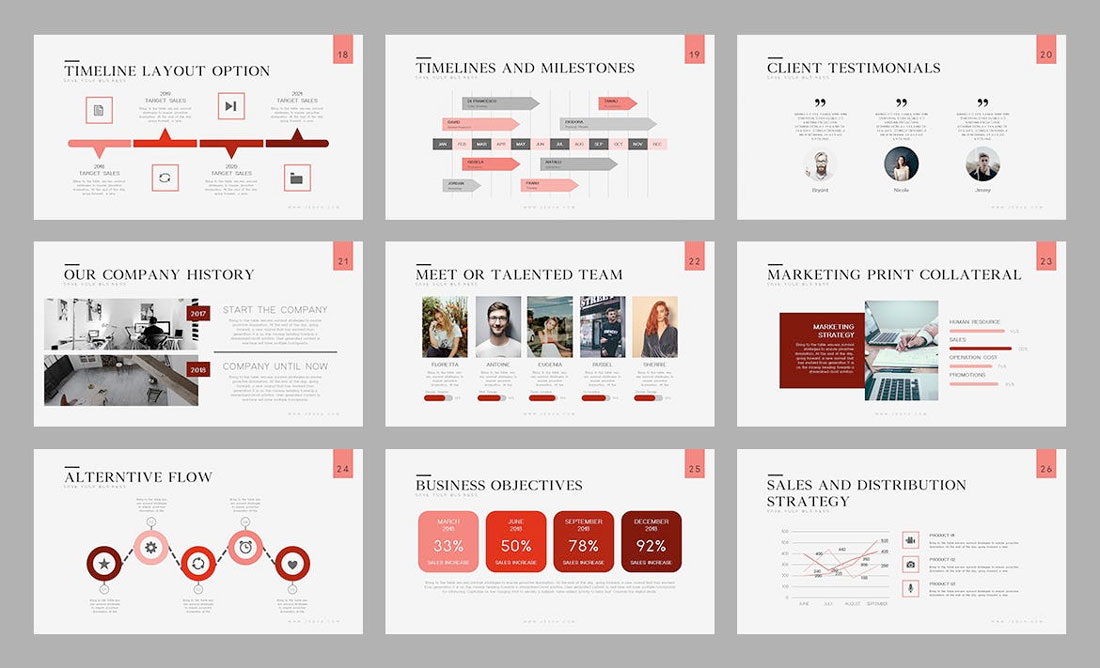
When it comes to creating the perfect pitch deck, where do you start? Great pitch decks have several things in common:
- Consistent and error-free design : Slides in the pitch deck must look like they belong together with a professional look and design that is free of errors. (Proofread it twice!)
- Something to hook the audience : Tell a story with words and visuals that engage people and make them want to be a part of your startup. You need to inspire them.
- Value proposition : What makes your company special, unique and valuable? What should investors expect as a return? Spell it out.
- Personality : A pitch deck should reflect your brand identity and personality.
- Template : Don’t reinvent the wheel every time you need to tweak or give your presentation to someone else. Create a template for your pitch deck (we have a few ideas below to help you get started and throughout this article) so that it’s quick and easy to prepare a presentation on the fly. You never know where the right opportunity might be waiting.
How to Create a Pitch Deck Design
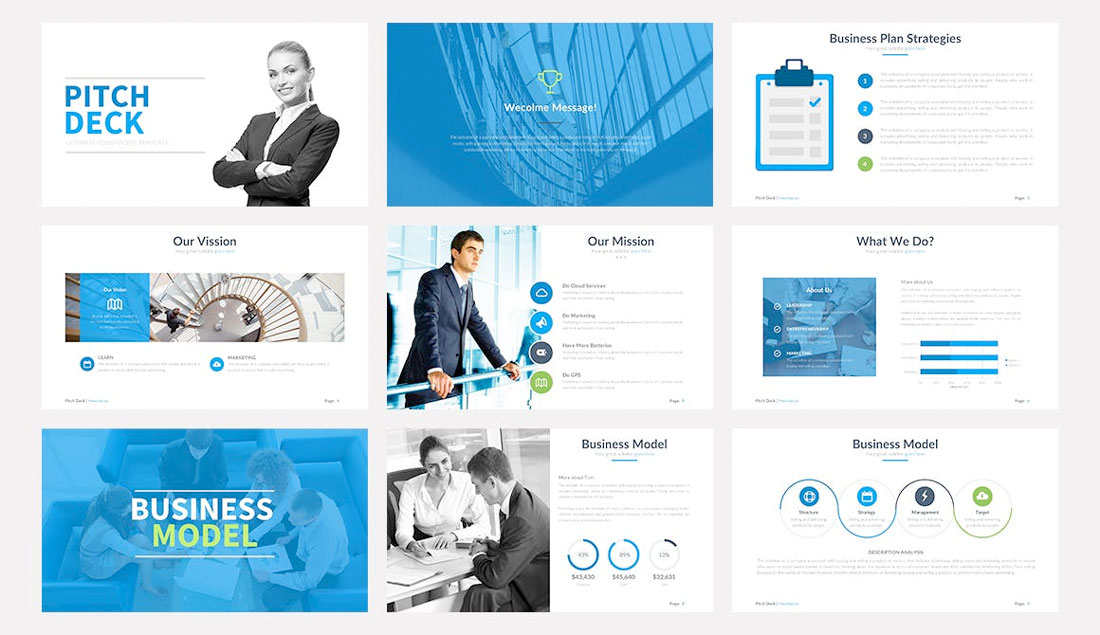
When it comes to creating a pitch deck, the design rules are pretty simple and consistent with many of the design concepts you’re probably already familiar with:
- Pick a consistent set of elements to use throughout the design. This includes a color palette, two to three typography choices and an icon set. Set styles and hierarchies for slides so that headers are the same throughout as are body text, photo use and other design elements.
- Limit the number of slides and feature one thing on each slide. Think of a slide as a single idea with an image and small text element. That’s all.
- Pick a design that works where you will be presenting. Will it be on a screen in a dark room? Or on a computer monitor at a desk? Or on an iPad with just one person looking on? Ensure that the design works in the place where you will show it.
- Save slides in a universal format, such as PDF, that will look and open like you expect.
Slides Every Pitch Deck Needs
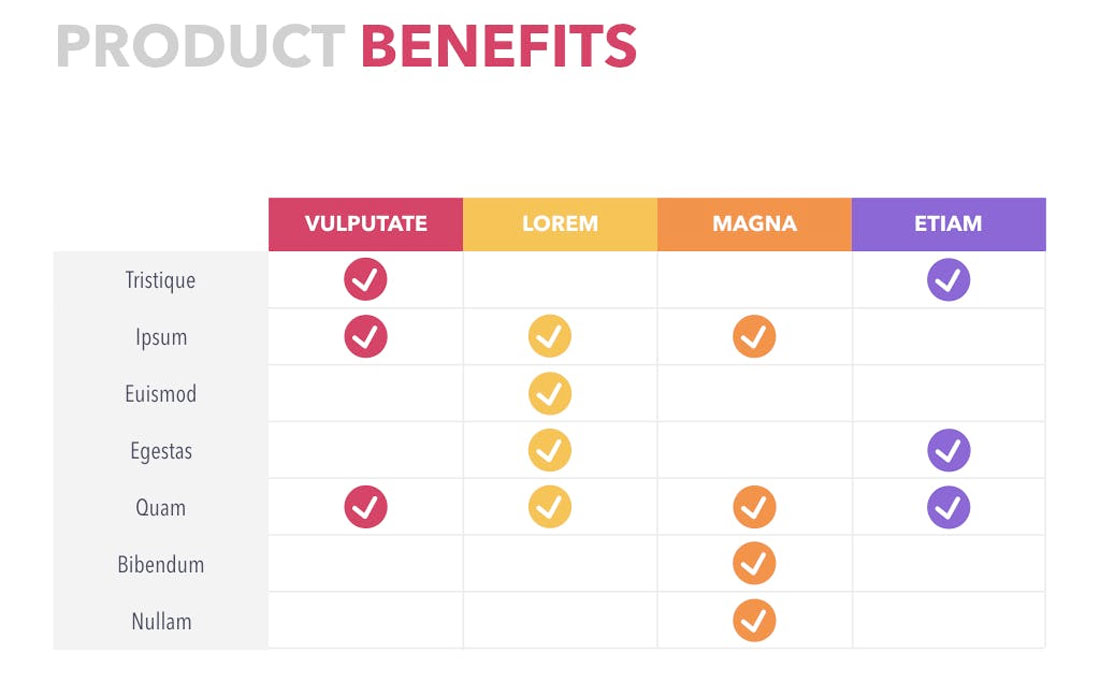
While every startup is different, there are a few slide types that almost every pitch deck needs to include. (Even if you aren’t using them all right now, it’s a good idea to plan for them as you grow and seek more funding.)
- Intro with company name/logo
- Vision and value proposition
- Problem that needs a solution
- How your company is that solution
- Target market and opportunities for growth
- Business model and roadmap
- Financials (with charts or graphs)
- Team members and bios
- Call for investment with how it will be used and benefits for investors
10 Pitch Deck Templates to Try
One of the quickest ways to do all of this – and create a stellar pitch deck – is with a template. Just pick a design that you like and customize it. Streamline the number of slides to just what you need and adjust colors, fonts and images to match your content.
A template can save you a lot of time, and there are so many professional and well-designed options out there, that there’s no reason not to try one. (Plus, the best pitch deck templates include slides for charts and graphs. Just fill in your data and share.)
Here are ten we like as inspiration for your pitch deck design.
Manola Presentation
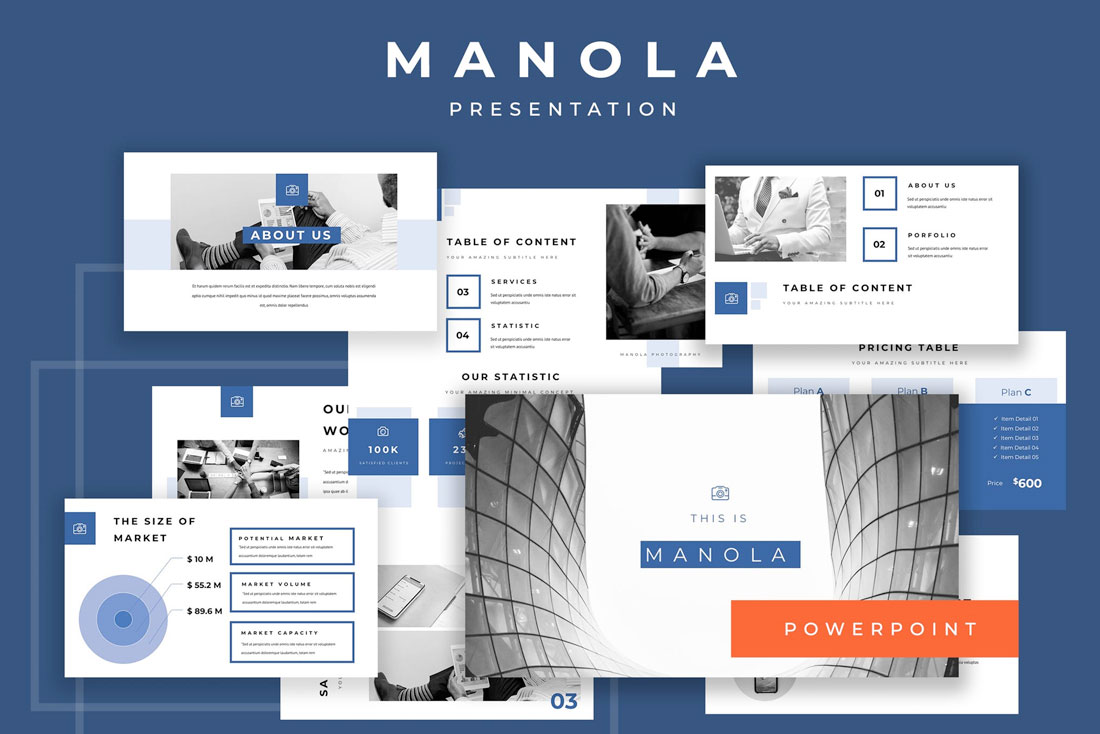
BISC Keynote Template
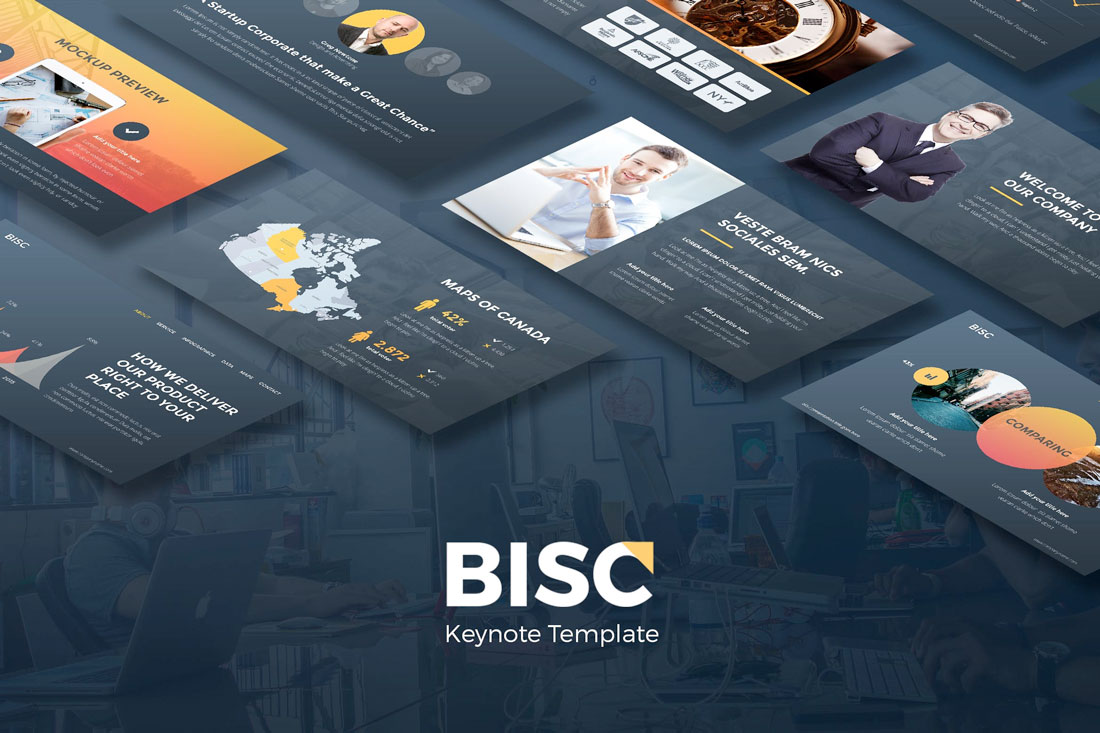
Business Pitch Deck Keynote
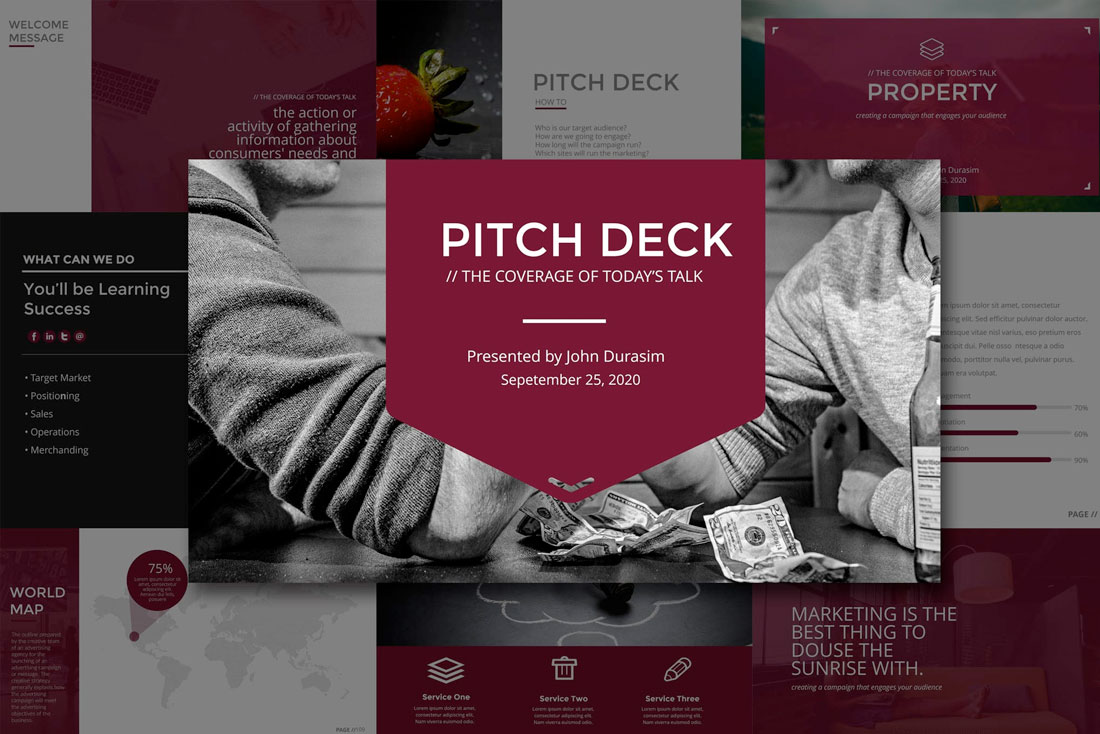
Startup Pitch Deck Template
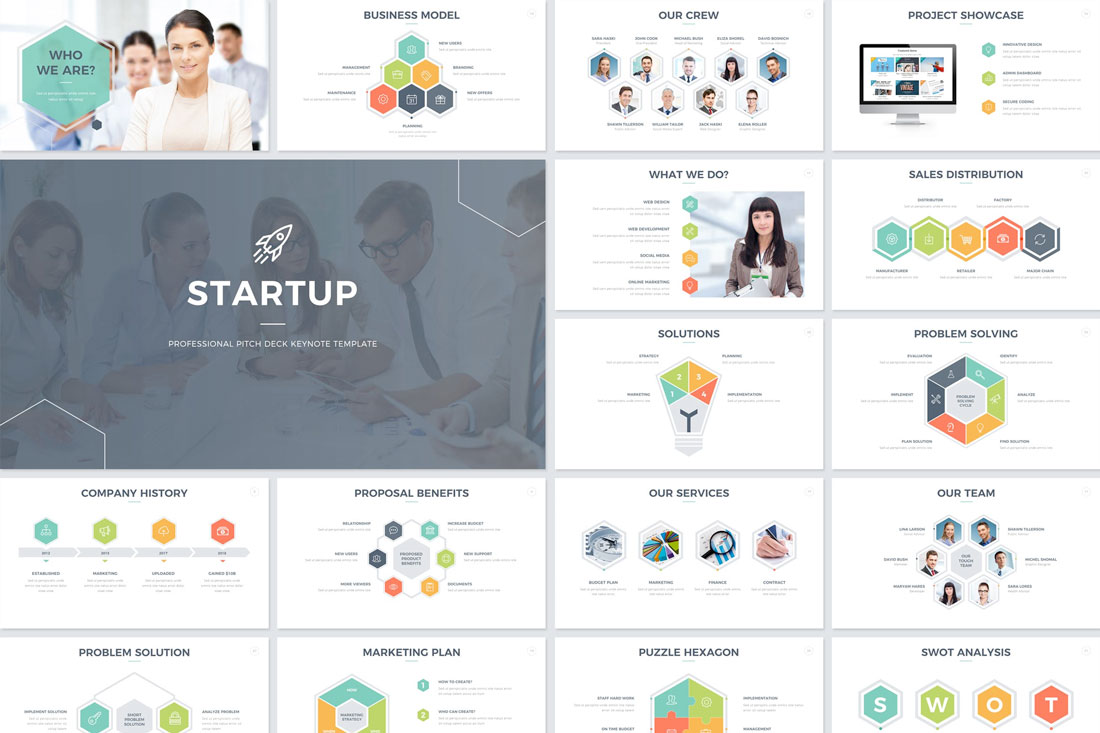
Corporate Business Plan

Union Keynote Template

Pitch Deck Google Slides

Secret: It’s Really Just a PowerPoint Template
If you haven’t figure it out yet, here’s the secret about pitch decks. They are really just PowerPoint (or Keynote) templates with a specific type of content included.
Need more inspiration? We have plenty more ideas for developing great presentations here .
What is a pitch deck?
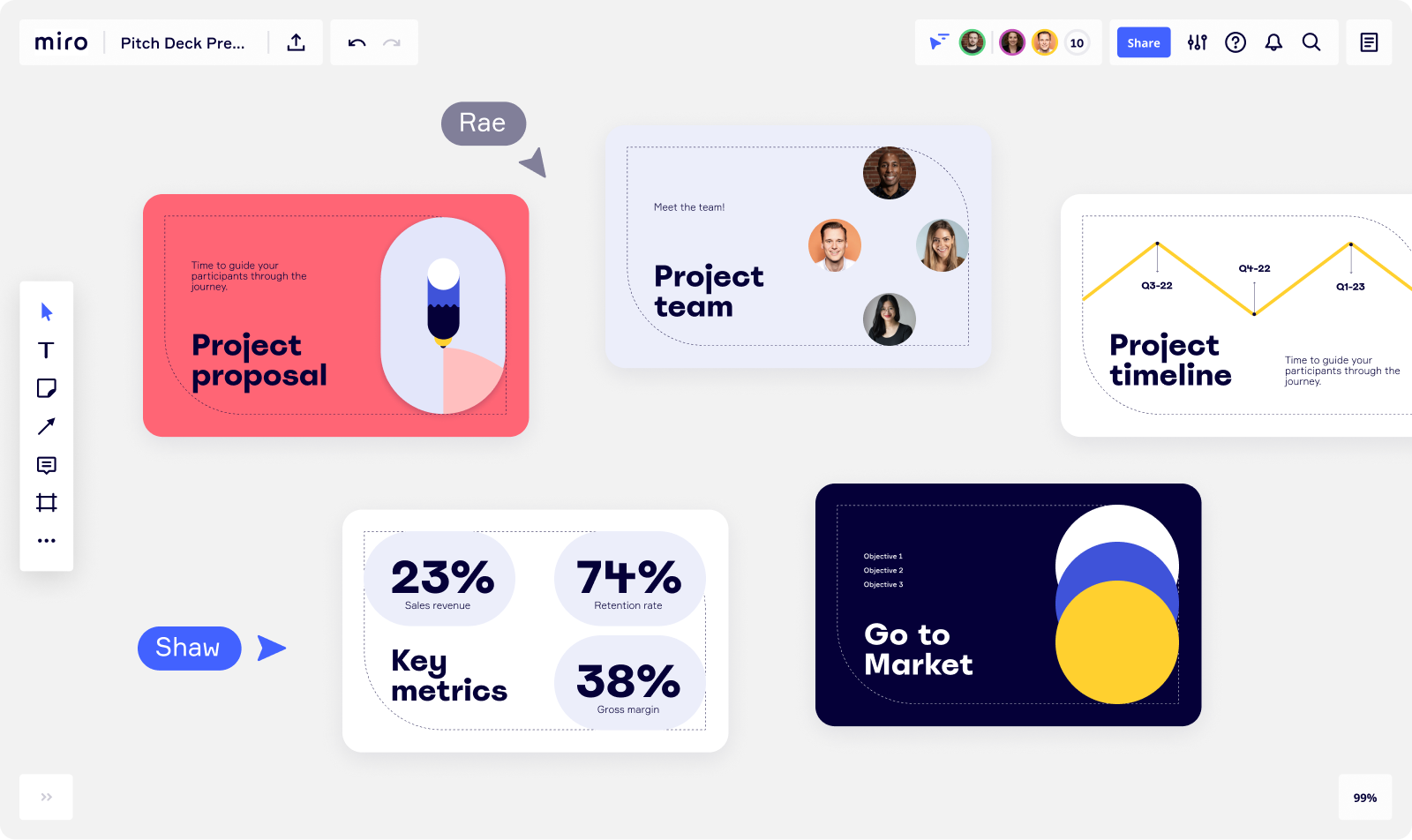
Table of contents
What is a pitch deck a quick guide.
A pitch deck is a presentation that provides an overview of a business, startup, or project to potential investors, partners, or stakeholders. It is typically a concise and visually engaging document that outlines key information — with the goal to communicate a compelling story about a project or new business and convince the audience of its viability and potential for success.
Pitch deck basics
A pitch deck, often considered the cornerstone of entrepreneur and investor communication, is a brief and visually compelling way to create a presentation that overviews your business. This invaluable tool provides a snapshot of your company's value proposition, market analysis, product details, and more. It's your golden ticket to securing the interest and backing of potential investors.
Understanding how a pitch deck works
Think of your pitch deck as your company's story condensed into a powerful narrative, the quintessence of your venture told through compelling visuals and concise text. This tool communicates the "what" and the "why" behind your business. It conveys your mission, vision, and strategy in an easily digestible format, ideally leaving investors intrigued and keen to know more.
What are the components of a typical pitch deck?
An effective pitch deck typically consists of the following elements:
Introduction : The essence of your company — what it is and what it does.
Team : Details about the skilled people driving your venture.
Problem : The issue your product or service aims to address.
Solution : Your unique value proposition.
Market analysis : Your target audience and market size.
Product : In-depth details about your product or service.
Business model : How you intend to make money.
Marketing and sales strategy : Your plan to attract and retain customers.
Financials : Current performance and future projections.
Ask : Your request from investors, whether it's funding, advice, or partnerships.
Advantages of making a pitch deck
The overall goal is to capture the audience's interest and generate enough enthusiasm for them to want to learn more or potentially invest in the business. A well-constructed pitch deck offers multiple benefits:
Clarity : By distilling your business into a pitch deck, you understand your venture more clearly, helping you articulate your vision effectively.
Investor attraction : An engaging pitch deck is a magnet for investors. It communicates critical details about your business and demonstrates your professionalism and commitment.
Guidance : A pitch deck provides a roadmap for investor presentations, guiding the flow of conversation and ensuring key points are addressed.
Successful pitch deck examples
To better understand how a good pitch deck should look, here are examples of 3 successful SaaS companies with great pitch decks:
Airbnb : Airbnb's original pitch deck succinctly outlined its unique value proposition, market analysis, and growth strategy. It effectively showcased their novel solution to a widespread problem, capturing investor interest.
Slack : Slack's pitch deck focused heavily on their product, using powerful visuals and simple explanations to communicate their platform's benefits. They underscored their unique selling points, clearly differentiating themselves from competitors.
Zendesk : Zendesk's pitch deck is a testament to the power of storytelling. They successfully used a narrative approach to guide potential investors through their customer service solution, making their proposition highly relatable.

How to make a pitch deck
Creating a compelling pitch deck involves thoughtful design, clear writing, and strategic storytelling. Here are some steps to guide you:
Understand your audience : Understand your potential investors' interests and concerns to tailor your pitch deck effectively.
Define your structure : Outline your deck using the key components mentioned earlier. This will serve as your pitch deck template .
Create your content : Keep your text succinct and impactful. Use data to support your statements and weave a compelling story around your business.
Design your slides : Use a clean, professional design. Leverage visuals and infographics to communicate complex information.
Refine and practice : Revise your deck, seek feedback, and practice your delivery. Remember, your pitch deck is not just a document — it's a presentation.
Tips and best practices when making a pitch deck
Less is more : Avoid cluttering your slides with text. Stick to key points and let your oral presentation fill in the details.
Consistency is key : Maintain a consistent design throughout your deck. This includes colors, fonts, visuals, and tone of voice.
Data-driven : Back your claims with relevant data. This demonstrates market understanding and adds credibility to your statements.
Tell a story : People connect with stories. Weave a narrative around your business journey, from the problem you're solving to the solution you're offering and your vision for the future.
Call to action : Make sure to include a clear 'ask'. Whether you're seeking funding, partnerships, or advice, be specific about what you want from your audience.
Creating a pitch deck might initially seem daunting, but with the right approach and tools, you can craft a compelling presentation that captures your audience's attention and leaves a lasting impression. Remember, your pitch deck reflects your business vision — it should not just inform but also inspire. Happy crafting!
How to make a product vision board
Read article
How to make a storyboard
How to make a mood board?
Get on board in seconds
Join thousands of teams using Miro to do their best work yet.
WHITNEY D. WALTER

PowerPoint Vs. Slide Deck, Slide Deck Meaning & More Simple Terms
Whitney D. Walter
Introduction
The terms “PowerPoint” and “slide deck” are thrown around a lot in the business world. So much so that you might be wondering if they mean the same thing or if there is something inherently different between the two.
The most significant distinction between a PowerPoint and a deck is that a “deck” is simply a collection of slides, whereas the term “PowerPoint” often refers to the final presentation which may be delivered in the form of a speech, video, or other format.
Here are a few examples of how a PowerPoint presentation can be used:
How do you make a good slide deck in powerpoint, what is a slide deck called in google slides, what is microsoft powerpoint.
Let’s start with the basics. Microsoft PowerPoint is a digital presentation tool. It’s a software application that allows users to share information and ideas with others.
- Creating an informational slideshow to share with colleagues or clients. This might include information about a new product, project details, or company updates.
- Developing a presentation to deliver at a conference or other professional event. This could include sharing research findings, pitching a business idea, or promoting a new initiative.
- Creating an educational resource, such as a lesson plan or study guide. This might include slides with information about a topic, along with accompanying questions or activities.
- Designing a sales deck to use when meeting with potential customers or clients. This could include slides outlining the features and benefits of a product or service.
PowerPoint presentations can be created using a variety of methods, including importing images, adding text, and inserting multimedia content.
Anatomy of a PowerPoint

What is a PowerPoint presentation?
You can think of a PowerPoint presentation as a vehicle to share information with others. Some people refer to a presentation as the act of actually presenting a slide deck. This can be in the form of a recorded slideshow, speech, or another delivery method.
Others may refer to presentations simply as the completed Powerpoint deck.
A typical PowerPoint presentation consists of a series of slides, each of which can contain text , images, and other multimedia content. PowerPoint also offers a variety of features, such as animations and transitions, that can help to make your presentation more engaging.
What is a PowerPoint slide deck?
A slide deck is simply a collection of slides. It can be created using PowerPoint or any other presentation software application, like Google Slides.
However, a key difference between a PowerPoint presentation and a slide deck is that a slide deck is not necessarily intended to be presented in a linear fashion. Instead, a slide deck can be used as a reference tool or resource, or it can be presented in a non-linear fashion, such as through an interactive website or app.
Why is it called a slide deck?
At this point, you might be wondering “But why are PowerPoints called decks?”. The term “slide deck” is derived from the old days of presentations when slides were physical transparencies that were loaded into a carousel and projected onto a screen.
These physical slides would be shuffled around to create the presentation, much like a deck of cards. Thus, the term “slide deck” was born.
In modern times, slide decks are usually presented electronically, either as a PowerPoint presentation or as a PDF. However, the term slide deck has stuck and is still used to refer to a presentation, even though there may not be any physical slides involved.
Why should you use PowerPoint slide decks?
A slide deck is an important tool for any presenter. It allows you to organize your thoughts and present them in a visually appealing way.
A well-designed slide deck can engage your audience and help you deliver your message effectively.
Is a deck the same as a PowerPoint?
Honestly, you will hear the terms “deck”, “presentation”, and “PowerPoint” used interchangeably in business settings.
The key difference between a presentation and a deck is that a deck is a collection of slides and a PowerPoint presentation could be given in the form of a speech, video, or other formats.
What is a PowerPoint slide?
A PowerPoint slide is a digital version of a traditional slide that is used to convey information during a presentation.
Unlike a traditional slide, which is typically created using a physical projector and an overhead transparency, a PowerPoint slide is created using software such as Microsoft PowerPoint or Apple Keynote. PowerPoint slides can be shared electronically with others via email or through
Simply put, consider each slide to be a digital page in your overall story.
What is the difference between a slide and a slide deck?
A slide is an individual page in a presentation deck while a slide deck is an entire presentation.
Each slide typically contains one main idea that contributes to the overall message presented with the slide deck.
At this point, you might be wondering how to make a good slide deck.
Here are a few quick tips:
- Start with a strong title slide that will grab attention and set the tone for the rest of the presentation.
- Be sure to include an agenda slide so your audience knows what to expect during the presentation. This helps with audience engagement.
- Use clean slide designs that are easy to read and understand.
- Try to limit each slide to one main point. Use images and graphics to support these points and tell the story.
- End with a strong conclusion that recaps what you covered, includes a call-to-action, provides relevant resources, and leaves your audience with a positive impression.
Creating a great slide deck takes time and effort, but it’s worth it. A well-designed slide deck can help you deliver a powerful presentation that will inform your audience and inspire them to take action.
Other Frequently Asked Questions
What’s the difference between a slide deck and a slide show.
A slide deck is a collection of slides that are typically used to give a presentation, while a slide show is may include media like images and video instead of traditional slides.
Slide decks are often created using PowerPoint or other presentation software, while slide shows can be created using a multitude of other multimedia programs.
There are many similarities between slide decks and slide shows, but there are also some important differences.
One key difference between slide decks and slide shows is that slide decks are usually static, while slide shows are often dynamic.
This means that slide decks typically don’t change much from one presentation to the next, while slide shows can be changed or customized for each individual presentation.
Slide decks are also usually shorter than slide shows, and they typically only include the most important information.
What’s the difference between a slide deck and pitch deck?
As we discussed, a slide deck is a collection of slides. The topic of these slides can be nearly anything under the sun.
A pitch deck is also a collection of multiple slides but the main difference is that all the slides are meant to serve a very specific business-related purpose.
The main idea behind pitch decks is typically to gain interest from investors. This is done by showcasing the potential of your business idea and/or product.
So while a slide deck can be about anything, a pitch deck will always cover information that will be of interest to potential business stakeholders.

The term “slide deck” is also used in reference to other presentation software like Google Slides and Apple’s Keynote .
Now that you know the difference between a PowerPoint presentation and a slide deck, you know that they are powerful tools that can be used to deliver effective presentations and engage your audience.
What tips do you have for creating effective slide decks? How have you used slide decks in your own presentations or business communications? Leave a comment and let me know!
Whitney is a recognized Professional Development Expert, professional speaker, and the founder of Harness Your Power. She holds a Master’s in Business Administration from Florida State University and a Microsoft PowerPoint Specialist certification. She has been featured in Yahoo Finance, AOL, Authority Magazine, Business Insider, Fox and more. Read more.
Similar Posts

How to Reduce Text on Your PowerPoint Slides
The human brain is a beautiful thing. We can recall distant memories, harness deductive reasoning, and empathize with our fellow humans in a matter of seconds. The funny thing is… It’s also an “ooh squirrel” type of thing. If we find ourselves listening to or looking at something less than interesting we can very quickly…

Tips for Quick Slide Design
“I’m not creative at all” is one of the most common complaints I hear when discussing PowerPoint design. There’s a misconception going around that you need to be Michelangelo to create good-looking presentations. The ironic thing is that you don’t need to create works of art to make an impact and drive your audience to…

How Using Images in Your PowerPoint Can Keep Your Audience Awake
Before we get into how using images in your PowerPoint can keep your audience awake, I have a confession to make. I’ve been guilty of falling asleep during meetings. Ok, don’t look at me like that! I’m sure I’m not the first person to doze off in the middle of a monthly business review. Be…

Everything You Need To Know: Add Fonts to PowerPoint
Microsoft PowerPoint has been the classic go-to for creating all sorts of presentations – whether you’re a business professional presenting to potential clients or just a university student presenting a project. PowerPoint boasts a number of customizations, so you are able to create a presentation exactly the way you want – from an extensive list…

PowerPoint Agenda Slide: What It Is & Easy Ways to Make One
If you’ve been creating Microsoft PowerPoint presentations for a while, you already know the benefits of starting with a good agenda. As a presenter, it allows you to take control of the conversation from the very beginning. You’ll also have the ability to eliminate audience distractions by clarifying the meeting objective and pointing out when…

Solved: How to Add Slide Numbers in PowerPoint
This article provides a step-by-step guide for how to add slide numbers to PowerPoint, as well as how to format and remove slide numbers.
Privacy Overview
10 Corporate Deck Examples & Templates (That Stand Out)
Get tips for creating an impressive corporate pitch deck, see high-performing corporate slide deck examples, and grab a battle-tested corporate deck template.
8 minute read

helped business professionals at:

Short answer
What does a corporate deck include.
A typical corporate deck includes the following elements:
- Introduction (UVP + hook)
- Problem (your market segment has)
- Solution (you have that no one can copy)
- Market size and opportunity
- Business and revenue model
- Traction and validation
- Marketing/growth strategy
- Team (authority & experience)
- Investment and use of funds
Without an outstanding deck, you won't get funded.
The highly competitive business landscape makes it challenging to impress investors with your pitch. Countless hours spent crafting the perfect pitch may not be enough.
If you don't have a well-crafted corporate deck, you risk losing investors and missing out on the funding your business needs to succeed.
Read on to learn the key components of a winning corporate deck and get insights from templated corporate deck examples that have successfully secured funding for other companies. Let’s go!
What is a corporate deck?
A corporate deck, or corporate pitch deck, is a presentation designed to convey the essential aspects of a business to potential investors, partners, or stakeholders. A corporate deck includes slides that outline the company's business model, products or services, target market, competition, team, financials, and growth strategy.
What is the goal of a corporate deck?
The goal of a corporate deck is to secure their investment, partnership, or stakeholder buy-in. To achieve this objective, corporate pitch decks should be heavily focused on showing the impact of the product, service or initiative on market-share, growth, and revenue.
If you're looking for other types of business presentations, check out our dedicated guides:
- Make a Sales Pitch Deck That Turns ‘Maybe’ to ‘Yes!’
- Create a Sales One-Pager (Examples, Writing Tips, Templates)
- Make a Winning Business Proposal Presentation in 12 Steps
- How to Create a Marketing Deck (Strategy, Tips & Templates)
Why most corporate decks fail (and how to avoid it)
The hard truth is that 99% of corporate decks fail to impress investors. That's a staggering statistic, but it's not surprising given the common pitfalls that many companies fall into when creating their presentations.
Here are the reasons why corporate decks fail and how to avoid these mistakes:
1. They use static slides that kill engagement
Static slides are engagement killers - there’s no option to visualize your data, include an actionable CTA, or deliver a pleasant reader experience on a mobile device.
Reengage your audience by incorporating interactive elements into your deck. Things such as videos, animations, clickable charts, or interactive ROI calculators.
Interactive content allows investors to explore the data on their own at their preferred pace. And when you allow investors to interact with your presentation, you’re increasing the chances of them reading it in full by 41% .

2. They offer facts rather than tell a story
Corporate slide decks that rely too heavily on listing out facts and figures are dry and tiring.
Instead of spouting facts, structure your deck around a compelling narrative that captures investors' attention and makes them care about your mission and vision.
If you’re not sure how to get started, here’s a video on how to improve storytelling in a pitch deck:

3. They are generic and fail to personalize
Investors are swamped with corporate decks on a daily basis, and they can smell generic from a mile away.
If you truly want to stand out from the crowd, you need to do your research ahead of time to understand the specific needs of your target audience.
By understanding what matters most to them, you can create a presentation that speaks directly to their concerns and demonstrates how your company can deliver value. Personalization gets 68% more people to read your deck in full .
4. They fail to use behavior data to continually optimize
Make sure you’re making data-driven decks instead of flying blind. If you’re sending out PDFs or PowerPoints that collect zero data about how readers engage with your deck there’s no way you’ll ever achieve a top performing deck.
The good news is that Storydoc decks collect insight on how your audience interacts with your deck, down to the slide and even button level. Where they skip, where they linger and when they share it with other decision-makers. Imagine what you could do with this info!

Corporate deck examples that stand out
A beautiful corporate presentation deck is a basic requirement - it’s not gonna make you stand out.
To create a deck that drives real results you’ll wanna take a close look at our list of the top corporate deck examples.
These corporate deck samples were all created using Storydoc and have been optimized for high engagement.
And the best part? All the examples are templated, which means you can use any of them to create your best-performing corporate deck in minutes!
Jump ahead to each example:
Startup pitch deck
What makes this deck great:
- The cover slide video enhances interaction, increasing engagement by up to 32% . This boosts the chances of potential investors reading the deck in its entirety and taking the desired action at the end.
- The roadmap slide offers a clear and concise presentation of your start-up’s journey. Meanwhile, various data visualization elements are perfect for demonstrating financial projections, proving that your business is making progress.
- The calendar integration on the final slide simplifies the process for investors to schedule the next meeting immediately after going through your corporate deck.
Light mode invest pitch deck
- The minimalist design makes your deck easy to follow even for those unfamiliar with the industry.
- With image and video placeholders , showcasing your solution and how it solves problems is effortless, without relying on complicated terminology.
- The interactive slides showcase the team behind your solution, illustrating their capability to steer it towards success.
Light mode product pitch deck
- The powerful personalization features enable you to produce an infinite number of versions of your deck in just a few clicks, resulting in 68% more people reading it entirely .
- The AI assistant lets you create relevant visuals or copy for the corporate pitch deck in just a few clicks.
- The intuitive editor automatically extracts the essential visuals of your company, ensuring that your deck maintains its brand consistency.
Investor pitch deck
- The fresh, contemporary design is sure to capture the attention of potential investors, particularly in trend-led industries.
- The perfect balance of text-based slides and engaging visuals enables you to present your key metrics while providing necessary context.
- The scroll-based interactive design facilitates explaining your solution to potential investors and guides them through a compelling narrative.
Pitch deck essentials
- The compact design makes it easy to communicate essential information in fewer slides, saving the investors' time.
- Various interactive slides provide potential investors with all the critical insights at first glance. By clicking through tabs, they can discover more about your solution, enhancing their engagement.
- The smart CTAs allow you to incorporate a live chat widget or calendar, smoothly directing potential investors to the next step.
Product pitch deck
- The combination of visual slides is ideal for presenting the product's primary features and use cases without overloading investors with walls of text.
- Videos that can be embedded and played directly from the deck allow you to include case studies from past customers to legitimize your product.
- An easy, intuitive editor ensures complete control over your presentation. If you release a new product version or make a typo in the specs, you can quickly make the necessary tweaks at any time, even after sending your deck.
- Powerful interactive design that doesn't detract from the main message. By using our running numbers slides and data visualization elements, you can present key metrics or financial projections to potential investors in an eye-catching, easy-to-understand format.
- Several data visualization elements that can be customized to your specific use case. You can also add real-time variables to your charts.
- The dynamic content allows your audience to interact with the deck. For example, you can embed an interactive ROI calculator that they can fill out to determine if they're getting their money's worth.
General invest pitch deck
- The versatile components make it suitable for pre-seed, seed, or series A funding. It includes all the necessary corporate deck elements that you can use to create a master deck.
- The ability to add customizable fields that can be filled in within seconds, making it possible to personalize your corporate deck at scale.
- The intuitive, user-friendly editor ensures that anything you add automatically adjusts to the overall deck layout. This means you don't have to worry about breaking the design.
Creative pitch deck
- The attention-grabbing design , featuring vibrant colors and animated elements, can convert casual scrollers into engaged readers.
- The fully interactive layout of this corporate deck increases interaction and extends the average reading time.
- The combination of visual and data visualization slides enables you to showcase snippets of your portfolio while emphasizing the most crucial metrics.
Bonus: successful corporate deck example by a Storydoc client
Finally, we left the best for last - a real-life corporate deck example created for one of our clients operating in the medical cannabis industry. It has been designed according to the best practices for creating a powerful corporate deck and delivered outstanding results.
- The running numbers slides enable readers to quickly and easily access the most critical metrics.
- The roadmap slide provides a clear and concise visualization of the company's current growth and significant milestones.
- The narrator slide simplifies complex financial metrics by directing the reader's attention to the exact numbers they should be focusing on at any given time.
How to create a corporate deck that stands out?
Putting together a corporate deck that leaves an impression and gets buy-in takes a lot of time and effort (and know-how) to get right.
But the truth is this task does not have to be so daunting. You can dramatically cut down the time and effort involved by leveraging corporate deck templates .
We have some tried and tested corporate pitch deck templates for you that are optimized for engagement and designed for making a lasting impression.
Make your best deck ever.
How to measure the effectiveness of a corporate deck.
To create a highly performing deck in the top 1%, it’s critical to measure performance, identify problems, and fix them.
Key corporate deck performance metrics to measure and optimize:
- Open rate: Measure the percentage of investors who open your corporate deck to understand how effective your deck is at generating initial interest.
- Reading time: Measure the total amount of time viewers spend reading your deck to gauge their level of interest.
- Engagement: Track how long viewers stay on each slide, how often they interact with the deck, or where they drop off to determine which parts of your corporate deck are most captivating and identify areas for improvement.
- CTA conversion rate: Measure the percentage of investors who take the desired action, such as scheduling a meeting, after viewing your corporate deck.
Here's a short video explaining how to get started with our analytics panel:

What is the best tool for making a corporate deck?
The best tool for making a corporate deck is intuitive, has lots of ready-made templates, and provides an outcome that stands out.
There are 2 types of tools on the market, legacy tools and next-generation tools, but only the next-gen tools will help you stand out.
Legacy tools like PowerPoint and Google Slides, Canva, and Visme will make same-old decks. But our own next-gen corporate deck creator makes interactive content experiences that make an impression.
Grab a template and see for yourself -

Hi, I'm Dominika, Content Specialist at Storydoc. As a creative professional with experience in fashion, I'm here to show you how to amplify your brand message through the power of storytelling and eye-catching visuals.
Found this post useful?
Subscribe to our monthly newsletter.
Get notified as more awesome content goes live.
(No spam, no ads, opt-out whenever)
You've just joined an elite group of people that make the top performing 1% of sales and marketing collateral.

Create your best corporate deck to date
Stop losing opportunities to ineffective presentations. Your new amazing deck is one click away!
Wondering why PowerPoint presentations are called decks? (Now you know)
Hrideep barot.
- Presentation , Public Speaking

Why PowerPoint presentations are called decks , a question that lingered in my mind for a long time until I decided to jump on to finding out exactly why! And here I am to share all that I have learned about why PowerPoint presentations are called decks.
But before we dive deeper into understanding PowerPoint decks, it is very important to refresh our knowledge of some of the basics.
What are presentations?
Presentations are a way of conveying some information, idea, or opinion to your audience either with or without the use of visuals, in most cases PPTs .
While most of the time, we are bound to confuse presentations with PowerPoint presentations, they aren’t the same thing.
Presentations are a much wider spectrum that includes PowerPoint presentations as a part of it.
What are PowerPoint presentations?
PowerPoint presentations are slide decks created on the specific software called Microsoft PowerPoint that was released by Microsoft (duh!) in the year 1987 . PowerPoint helps create easy and effective digital slide decks; since it is so widely used, it has become synonymous with presentations at large.
It is similar to how we call photocopies Xerox!
(pst if you don’t understand the analogy, check out what we are trying to say here )
Why are PowerPoint presentations called decks?
Decks in presentations are a collection of slides (individual pages in PowerPoint) . And since PowerPoint presentations are nothing but a collection of well-laid-out slides, they are called decks.
Now to understand it better, let’s begin with the fundamental structure, shall we?
Assuming you go to PowerPoint right now, what is the first thing you’ll see?
A blank template that would prompt you to add text, right? That is a slide. As you keep adding slides to your PowerPoint, the collection of these slides, in the end, is what we call a deck.
But then again,
Why is it called a PowerPoint deck?
A PowerPoint deck is similar to a deck of cards. In a deck of cards, a deck is composed of 52 cards; Similarly, in PowerPoint, a deck or pile of slides is what is known as a PowerPoint deck.

So, does this mean that the presentation is important only in its entirety and not as individual slides?
Absolutely no!
Just like in a game of cards, the ace carries its importance and so does a card of jack; In PowerPoint decks too, each slide carries with it its unique importance . However, when separated the slides would lose their meaning.
Again, what would you do if you find a queen card lying on your room’s floor? slide it under the bed? I mean it would be ideal considering you don’t know where the rest of the cards are!
Similarly, individual slides gain their meaning when they are compiled with other slides.
This means each slide carries its own different set of information that helps in conveying an idea at the end .
When did PowerPoint presentations become decks?
PowerPoint presentations became decks on the day they came into being, that is in 1987.
Presentations had been made using stacks of papers or sheets filled with information even before digital presentations came into being.
As shocking as it may be, presentations already involved the use of decks in some form or the other from the very initial day of the specification building our communication skills.
While we started with rock paintings or carvings, we can include them as a form of presentation but not as decks.
Later came the use of sheets or paper to deliver information. This was done using flip paper cards .
There is evidence that presentations using flip charts became very common during the 1940s. These sheets or posters would be joined together with the help of metal fasteners. The speaker or presenter would then flip from one page to the other to share information.
Sounds very similar to our digital presentations, doesn’t it? Except we don’t have to tire our arms by flipping pages. We can simply click to move on to the next slide. How convenient!
Coming back to the last bit of our history of slide decks, somewhere in the 90s -2010’s PowerPoint as a software gained major attention from the public. The slide decks started to be created on PowerPoint exclusively and that is how we moved from saying slide decks to PowerPoint decks.
Going over it again
What is a slide deck in powerpoint.
A slide deck in PowerPoint is nothing but a collection of slides in Microsoft PowerPoint.
What is a PowerPoint slide deck?
It is just another way of saying Slide decks in PowerPoint!
Why are PowerPoint slides called decks??
Since PowerPoint gives you a collection of slides or a deck of slides, it is known as decks.
What is the purpose of a Slide deck in a presentation?
Slide decks help the presenter present his/her/their topic more effectively. It aids the presenter in giving the speech by providing prompts or hints to maintain a flow in their speech. On the other hand, it helps the audience visualize as they listen to the speaker.
Out of the many purposes that a slide deck can serve a presenter, here are a few that we would like to address in this article:
- To pitch new ideas or products
- To explain or introduce a concept
- To share one’s opinions or views
1. To pitch new ideas or products
Slide decks happen to be a very crucial part of making pitches to attract your clients, or to make them understand what your product/ services are all about and how they can be beneficial to them.
Some of the ways we can try to win over or convince the client/ customer to agree to your terms are by showing charts or graphs of your previous success rates or giving out statistics on the problem that your company or product provides a solution for.
2. To explain or introduce a concept
Slide decks being used to explain a concept is something that I believe we have all experienced in schools or colleges.
With smart classrooms, the blackboards have found their place in restaurants and cafes and presentations have made their way to now be a widely used way of delivering lectures.
3. To share one’s opinions or views
Be it in conferences or competitions or even in your college when you are presenting on a topic, it is mostly with the purpose of sharing your opinions, views, or findings through slide decks.
How do you create a deck in PowerPoint?
When it comes to creating decks in PowerPoint, there are two things that we need to take a look into, the technical aspects and the aesthetic ones.
When we talk about the technical aspect of creating a deck in PowerPoint, we mean ensuring that you have the software installed in your system, be it a laptop or even your phone.
Head to AppStore or play store and install it.
Though we have been taught how to create PowerPoint presentations since very early days, we still suggest you take a minute and understand the various features offered by the software like the layouts, themes, and more. Having an understanding of some of the basic features can help you in creating a basic template easily!
If, however, you are looking for ways to create a slide deck other than on PowerPont, then head to some of the most resourceful sites that provide you with a number of templates!
A few such sites are Canva , Evanto , and more
Now when we talk about the Aesthetics of creating a PowerPoint, we first need to accept and appreciate the fact that the aesthetics or look of your presentation can add extra points to your entire presentation.
We have a list of 5 tips for the same. And if you follow them, you will surely be able to find an answer to..
Why are PowerPoint presentations effective?
A few tips for creating presentations:
1. Less is more
We have all heard this one a gazillion times and more, especially when it comes to Powerpoint presentations, Less is more!
Provide very precise information in your PowerPoint. To make your points short. You can stick to using the 5 by 5 model . The model suggests that you must not add more than 5 points to a slide. And each point must contain no more than 5 words.
If you still have no idea what you should add, try adding your headings and subheadings in your PowerPoint to make it more on point.

2. Quality over quantity
Again, adding less content doesn’t mean that you compromise on the quality of information that you share through your presentation. Add short points that make sense and add value to your audience or help in putting your point across in the best way possible.
3. Keep the curiosity alive
What does it mean when we say keep the curiosity alive? We mean, try not to share your entire slide to your audience in one go. Add effects or transitions to focus only on the point you are speaking on at that point.
We can say the same in the case of adding too much information to your PowerPoint. Do not add big paragraphs as you shatter your viewer’s curiosity who thanks to you ar enow more engrossed in reading the slides than listening to your presentation.
4. Neutralize your PowerPoint
By neutralizing we mean adding complementing slides to your PowerPoint decks. If you have selected a more dark theme, try neutralizing it with light-toned slides even if it is used as a transition slide.
5. Add visuals as and when possible
Ask yourself, can the information that you have added in your PowerPoint presentation be presented in the form of a graph, a table, or a diagram? If yes, then always choose to do it. Switch to visuals as it not only makes your content crisper but also is more appealing to the viewers.
This brings us to our next point,
Why PowerPoint presentations are not effective?
There are many reasons why PowerPoint can not be very effective. We have listed down about 3 reasons here. Go over them and try to not make the same blunders if you want to be an effective presenter!
1. Tons of Content
Adding more content to your slide may indeed help you remember the content better but it might bore the audience to death.
So just as we discussed, try to add content to your presentations in the form of short pointers. Or least try to make use of keywords and avoid writing entire paragraphs about your topic on the PowerPoint presentation.
An example of what simply copy-pasting a paragraph from your speech to PowerPoint could look like.

2. Poor color/ theme
The last thing we want is for the audience to struggle reading or seeing what we are trying to show them through the presentation. And this situation can possibly happen when there was little to no thought put into either selecting the right theme or use of overlapping colors.
Check out the example below if you want to take a look at what we are talking about!

3. Poor font choice
Another way of making it difficult for your audience to understand your presentation is by using fonts like the one shown in the picture below. Such fonts may surely be a little different, and to some extent aesthetic but it requires lots of effort from the viewers to actually understand what is written on the slide!

Final words
Let us try to summarize the entire blog for you in a couple of lines.
So essentially call it decks, slide decks, or presentation decks, they all mean the same. It is simply a collection of slides. And when such a collection is made on Microsoft’s PowerPoint, what do we call it?
Yes! you guessed it right (Hopefully?)
It is called PowerPoint decks or slide decks on PowerPoint.
There are tons of ways of making a PowerPoint deck. However, focusing on the template, and theme, and adding precise and quality content can help you go a long way.
That’s about it for now! Check out Frantically Speaking for more information on similar topics.
Enroll in our transformative 1:1 Coaching Program
Schedule a call with our expert communication coach to know if this program would be the right fit for you

How to Negotiate: The Art of Getting What You Want

10 Hand Gestures That Will Make You More Confident and Efficient

Interrupted while Speaking: 8 Ways to Prevent and Manage Interruptions

- [email protected]
- +91 98203 57888
Get our latest tips and tricks in your inbox always
Copyright © 2023 Frantically Speaking All rights reserved
Kindly drop your contact details so that we can arrange call back
Select Country Afghanistan Albania Algeria AmericanSamoa Andorra Angola Anguilla Antigua and Barbuda Argentina Armenia Aruba Australia Austria Azerbaijan Bahamas Bahrain Bangladesh Barbados Belarus Belgium Belize Benin Bermuda Bhutan Bosnia and Herzegovina Botswana Brazil British Indian Ocean Territory Bulgaria Burkina Faso Burundi Cambodia Cameroon Canada Cape Verde Cayman Islands Central African Republic Chad Chile China Christmas Island Colombia Comoros Congo Cook Islands Costa Rica Croatia Cuba Cyprus Czech Republic Denmark Djibouti Dominica Dominican Republic Ecuador Egypt El Salvador Equatorial Guinea Eritrea Estonia Ethiopia Faroe Islands Fiji Finland France French Guiana French Polynesia Gabon Gambia Georgia Germany Ghana Gibraltar Greece Greenland Grenada Guadeloupe Guam Guatemala Guinea Guinea-Bissau Guyana Haiti Honduras Hungary Iceland India Indonesia Iraq Ireland Israel Italy Jamaica Japan Jordan Kazakhstan Kenya Kiribati Kuwait Kyrgyzstan Latvia Lebanon Lesotho Liberia Liechtenstein Lithuania Luxembourg Madagascar Malawi Malaysia Maldives Mali Malta Marshall Islands Martinique Mauritania Mauritius Mayotte Mexico Monaco Mongolia Montenegro Montserrat Morocco Myanmar Namibia Nauru Nepal Netherlands Netherlands Antilles New Caledonia New Zealand Nicaragua Niger Nigeria Niue Norfolk Island Northern Mariana Islands Norway Oman Pakistan Palau Panama Papua New Guinea Paraguay Peru Philippines Poland Portugal Puerto Rico Qatar Romania Rwanda Samoa San Marino Saudi Arabia Senegal Serbia Seychelles Sierra Leone Singapore Slovakia Slovenia Solomon Islands South Africa South Georgia and the South Sandwich Islands Spain Sri Lanka Sudan Suriname Swaziland Sweden Switzerland Tajikistan Thailand Togo Tokelau Tonga Trinidad and Tobago Tunisia Turkey Turkmenistan Turks and Caicos Islands Tuvalu Uganda Ukraine United Arab Emirates United Kingdom United States Uruguay Uzbekistan Vanuatu Wallis and Futuna Yemen Zambia Zimbabwe land Islands Antarctica Bolivia, Plurinational State of Brunei Darussalam Cocos (Keeling) Islands Congo, The Democratic Republic of the Cote d'Ivoire Falkland Islands (Malvinas) Guernsey Holy See (Vatican City State) Hong Kong Iran, Islamic Republic of Isle of Man Jersey Korea, Democratic People's Republic of Korea, Republic of Lao People's Democratic Republic Libyan Arab Jamahiriya Macao Macedonia, The Former Yugoslav Republic of Micronesia, Federated States of Moldova, Republic of Mozambique Palestinian Territory, Occupied Pitcairn Réunion Russia Saint Barthélemy Saint Helena, Ascension and Tristan Da Cunha Saint Kitts and Nevis Saint Lucia Saint Martin Saint Pierre and Miquelon Saint Vincent and the Grenadines Sao Tome and Principe Somalia Svalbard and Jan Mayen Syrian Arab Republic Taiwan, Province of China Tanzania, United Republic of Timor-Leste Venezuela, Bolivarian Republic of Viet Nam Virgin Islands, British Virgin Islands, U.S.
- Data, AI, & Machine Learning
- Managing Technology
- Social Responsibility
- Workplace, Teams, & Culture
- AI & Machine Learning
- Diversity & Inclusion
- Big ideas Research Projects
- Artificial Intelligence and Business Strategy
- Responsible AI
- Future of the Workforce
- Future of Leadership
- All Research Projects
- AI in Action
- Most Popular
- The Truth Behind the Nursing Crisis
- Work/23: The Big Shift
- Coaching for the Future-Forward Leader
- Measuring Culture

The spring 2024 issue’s special report looks at how to take advantage of market opportunities in the digital space, and provides advice on building culture and friendships at work; maximizing the benefits of LLMs, corporate venture capital initiatives, and innovation contests; and scaling automation and digital health platform.
- Past Issues
- Upcoming Events
- Video Archive
- Me, Myself, and AI
- Three Big Points

How to Create Slides That Suit Your Superiors: 11 Tips
When you’re pitching ideas or budgets to execs in your organization, you need to deliver slides that fit those particular people just right. This checklist identifies the key considerations.

- Workplace, Teams, & Culture
- Leadership Skills

Carolyn Geason-Beissel/MIT SMR | Getty Images
I recently interviewed 20 of my customers, all in senior roles at Fortune 100 companies, and asked them their biggest pain point in presenting to higher-ups and even colleagues. What I heard consistently was that it can feel like Goldilocks bouncing from one option to the next, testing to figure out what’s “just right.” Does the audience want deep reports? Sparse slides? Something in between? Like … what?
Teams often come to presentation meetings with vast amounts of backup content just in case an exec wants to take a deep dive on any given point. There’s often a struggle to anticipate every direction attendees might want to go. It’s frustrating, and it’s not efficient.
Get Updates on Transformative Leadership
Evidence-based resources that can help you lead your team more effectively, delivered to your inbox monthly.
Please enter a valid email address
Thank you for signing up
Privacy Policy
There are many ways to build slides. I’m not just talking about crafting them well versus poorly. I’m talking about all of the important decisions regarding how to organize them, how much text to use, when to lean into a chart, the best ways to use bullets and color, and whether to include an appendix with additional information. Before you make your next proposal or request of the executive team, use this list of 11 tips for your next set of slides as a guide.
Four Things You Must Have in Every Exec’s Slides
Before we drill down into the harder aspects, the ones where your executives’ tastes may vary widely, let’s quickly cover four aspects that you can consider the building blocks — the basics you should never proceed without.
Start with an executive summary. Begin the slide deck with a tight executive summary that follows a three-act structure. First, start with stating the current realities. Second, clearly state the problem or opportunity your idea addresses and its potential impact. Third, explain how your recommendation solves the problem or exploits the opportunity and the next steps you’re proposing.
Have a logical organization. The arc of the deck — the package from beginning to end — should make sense. If your audience reads only the headline of every slide, the order should be coherent and make most of the case for you. The content below each slide’s headline must support the statement made in the title. Remove everything that doesn’t support your point; as writers will tell you, you sometimes need to “kill your darlings” when you’re editing.
Begin the slide deck with a tight executive summary that follows a three-act structure.
Make it skimmable. Help your audience to quickly grasp the point without getting bogged down in details. Create a clear visual hierarchy. Guide the reader’s eye through the content: Use bold headings, bullet points, and numbered lists to break down information into digestible pieces. Highlight key takeaways or conclusions in a different color or font size to draw attention to these critical points.
Focus on concise insights. Succinct statements with clear insights are everyone’s jam. Every slide should serve a purpose and contribute directly to the decision-making process. Distill complex information. Don’t use 100 words when 20 words will nail it. If you’re having difficulty trimming, consider using company-approved AI tools to help you take out the fluff.
Five Preferences to Confirm With the Person You Want to Reach
Now we’ll delve into what your particular audience does and does not want. If you haven’t yet, start by asking the person you’re presenting to what they generally prefer. They probably know themselves well but have not been asked to articulate how they like to receive information.
Ask how dense is too dense. Some executives prefer detailed slides with comprehensive data. Others favor a more high-level approach. You’re weighing how to balance informative content with readability, ensuring that slides are not overloaded yet are sufficiently detailed to support decision-making.
Confirm the delivery format and timing. Some execs like information presented to them. Others prefer a pre-read of the material followed by a discussion. I always recommend our tool Slidedocs (I’ve written a free e-book on them), which are visual documents using both words and images. The templates help presenters organize their thoughts into a document for a pre-read or a read-along. They are designed to be skimmable and able to travel through your organization without the help of a presenter.
I’m a huge fan of pre-reads and prefer to use my time in meetings to ask questions and build alignment. If your audience didn’t review your material in advance, ask at the top of the meeting whether they would like you to present it or would prefer to read through it and then discuss it.
Find out how much data visualization they prefer. Charts, graphs, photos, and illustrations often communicate complex data more clearly than words alone. When execs can see what you’re saying, they often can better understand the impact of your idea. Does the exec want to understand exact numbers? Bar charts allow them to move their eyes across a series of specifics. Does the exec want to know the shape of a trend over time? Line charts can show the pattern. (See “Classic Charts Communicate Data Quickly.”) Some prefer charts with annotations that draw attention to what you think is the most important point. Others want to make their own conclusions from the data.
One of my clients, the CEO of a massive commercial real estate company, doesn’t want anything visualized. He prefers numbers, only in a table, and only in two colors — black and red. You might think this is archaic. But the fact that he’s clear to his teams about what he wants takes all the mystery out of how to communicate with him.
When the stakes are high, have a conceptual thinker help with diagrams and concepts. If you don’t have one on your team, and when it’s high stakes, find an internal designer to help you or hire one. You can’t afford to have the baby (your idea) thrown out with the bathwater (terrible slides).
Identify which details need spelling out. How well do the people you’re presenting to know the landscape and function of the company and products you’re talking about? For example, if your engineering team threw a slide into a deck about an issue that requires executive approval, do the execs all speak geek? Or do you need to explain the technology so that they will really understand the ask? Either eliminate internal jargon and acronyms or unpack those bits, especially if your proposal deeply involves expertise outside of the executives’ domain.
Ask whether appendices will be useful. When you’re organizing a presentation, you often troll data, read through complicated reports, and even hire external experts to figure out what’s best for the company. Do your execs want access to that supporting data? You can add a document to the end of the presentation as an appendix to show all of the data and source material. This allows the main content of the slides to remain focused and accessible while still providing comprehensive background information for those who want more.
Two Tips to Improve Your Presentation Skills
Getting materials in place is the biggest step. They will be your best tools for selling your ideas. But there are two extra areas to pay attention to as a presenter: how you handle questions and how you use every experience to improve.
Anticipate questions, and practice your answers. Before you have your meeting, gather a small team to challenge every point you make. Invite colleagues you trust to role-play as “a rapidly inquisitive exec” or “the doubting naysayer exec” so you are prepared to present your idea well. They’re gonna grill you, and practicing will help you remain unruffled when it happens.
Related Articles
Ask for feedback after the presentation. Establish a feedback loop with those you presented to. Ask what worked well and how you can improve. If attendees don’t have the time, find people who have had their ideas funded and talk to them about what they did that worked. Advice and some perspective will help you nail your performance even better next time.
Empathetically understanding your audience members and how they process information, whether it’s executives or peers, sets up your ideas for success. Clarity creates efficiency. When a presentation fits just right, you’ve given your great thinking the best chance of moving through your organization and having maximum impact.
About the Author
Nancy Duarte is CEO of Duarte Inc. , a communication company in the Silicon Valley. She’s the author of six books, including DataStory: Explain Data and Inspire Action Through Story (Ideapress Publishing, 2019).
More Like This
Add a comment cancel reply.
You must sign in to post a comment. First time here? Sign up for a free account : Comment on articles and get access to many more articles.
What Is a Marketing Deck? Tips, Examples, and Templates
December 2, 2021
by Kai Tomboc

In this post
What is a marketing deck, what are marketing decks for , why is a marketing deck important for your business, the essential components of a marketing deck.
- How to build a marketing deck
- Examples and templates of marketing decks
One of the frustrating things about marketing a brand or business is capturing your target audience’s attention.
Potential partners and customers are busy folks, and it can be a challenge to share your brand story and business model in a short amount of time. This is where a marketing deck enters the picture.
Whether your business is new to the scene or around for decades, a solid marketing deck plays a crucial role in getting your company off the ground. It can mean the difference between booming sales figures and a lagging product launch.
What is a marketing deck exactly? What does a great marketing deck look like? Most of all, why should brands care about creating a well-designed deck for marketing?
Get answers to these questions and discover marketing deck examples and templates that you can use every time you’re about to design a pitch deck for your marketing efforts.
Let’s get started!
A marketing deck, also known as a pitch deck, is a visual marketing presentation of your product or service. It aims to educate potential investors, co-founders, partners, and customers about your product or service.
Marketing decks can have different purposes both internal and external. For example, marketers and advertising teams use certain decks for internal presentations. These are often referred to as snapshot decks and can include metrics and data for a specific period. Website traffic and foot traffic to a retail store are good examples of snapshot decks.
Meanwhile, the terms marketing deck and sales deck can be used interchangeably because, in some cases, the purpose of a marketing deck is to close a sale when you’re making a sales pitch .
An effective marketing pitch deck should be easy to understand, convey trustworthiness, and be persuasive enough to elicit FOMO from your audience.
The primary purpose of a marketing deck is to persuade your target audience about the value of your product, service, or business idea. Ideally, your audience should be able to recognize the need to support, purchase, or advocate for your brand after viewing it.
It’s also worth noting that marketing decks don’t have to be associated with startups alone. Businesses of all shapes and sizes can use them as a powerful, persuasive tool, whether online or in face-to-face presentations.
You’re not aiming for a fancy talk or a highly detailed presentation when presenting this type of deck. The best decks present lean yet relevant information to their target audience concisely and straightforwardly.
When you present your marketing deck, your audience expects the following information:
- Overview of your product or service
- Your target market
- The problem you’re solving
- How your product or service can specifically address the problem
- Your pricing
- Current traction (in stats)
- Business goals and how your team intends to accomplish these goals
- What makes you different from the competition
Finally, marketing decks are usually created using PowerPoint, Google Slides, and other presentation software tools .
Regardless of your niche, size, and industry, a marketing deck offers the following benefits:
- The information you provide helps potential investors and partners decide if they want to take the next step (usually a meeting) in investing in your business.
- It also helps explain what your business does to prospective employees, customers, and clients.
- It's a living document that you can change and modify as your business needs and goals evolve.
To sum up, a well-thought-out marketing deck is a solid business asset for organizations looking to grow, whether through securing more funding or acquiring more customers and partners.
Getting your marketing deck right can make or break your business. For this reason, you need to understand the essential components of an effective one .
Below is each component in detail with sample slides from popular marketing deck designs to inspire you the next time you're about to pitch your business .
1. Overview of your company
The first component in your marketing deck presentation should introduce your company, product, or service in one sentence. It's also important to state your unique value proposition (UVP) in this slide. Think of it as your power statement, and it should answer, "Who are you, and why should we listen to you?"
For this slide, don't forget to include your logo, phone number, and email address. The presentation below from Manpacks is a good example of an overview deck. Manpacks bagged a good round of funding using this presentation.
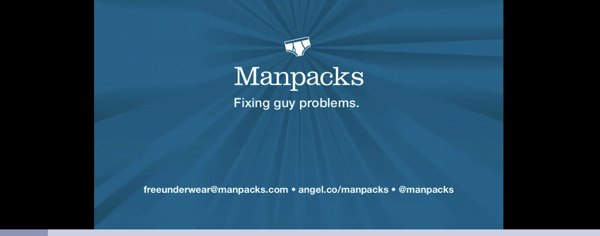
2. Information about your target market
This component should include your audience's demographics, market size, and market opportunity to succeed in the space. You can also highlight market validation or the process of figuring out if there's truly a need for your product or service.
Take a look at Airbnb's marketing size and market validation slides when they were just starting.
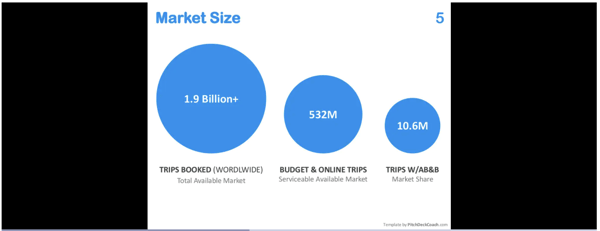
3. The problem
The third component highlights the actual problem that your product or service will address. In the sample slide below, Castle, a real-estate startup, raised $270,000 using this marketing deck.
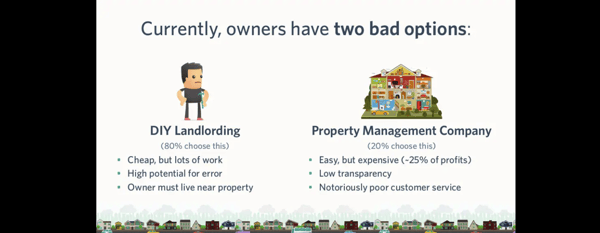
This slide should answer the following questions:
- What are you trying to address?
- Who are the people experiencing the problem?
- What is the problem’s impact on the people experiencing it?
- How does the person address the problem right now, and are these solutions helping them?
If you can’t show you’re solving a real problem or pain point, your audience might lose interest in your presentation. A good practice when presenting a problem is to share a story.
You can further capture your audience’s attention by using visuals to explain complex issues. Finally, it also helps if you can illustrate how serious the problem is through data.
4. The solution (your product or service)
After sharing the problem you’re solving and the corresponding market opportunity, your next step is to spotlight your solution! Paint a picture of your unique value proposition and support it with relatable anecdotes and visuals like video clips, photographs, or even a physical demo of your product.
At this point, don’t get too caught up in describing your solution in detail. Instead, provide a higher-level overview of your solution. Here’s how LinkedIn did it back in 2004.
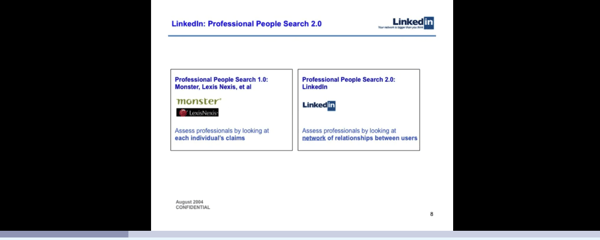
5. Traction
This component will help validate whether or not your business model works. Focus on numbers that have contributed to your growth, like month-to-month sales figures, the number of app downloads, or your profit margins. The goal is to reduce any fear of risk in potential investors.
Take it from Single Music, a platform that allows artists to monetize their Spotify profiles.
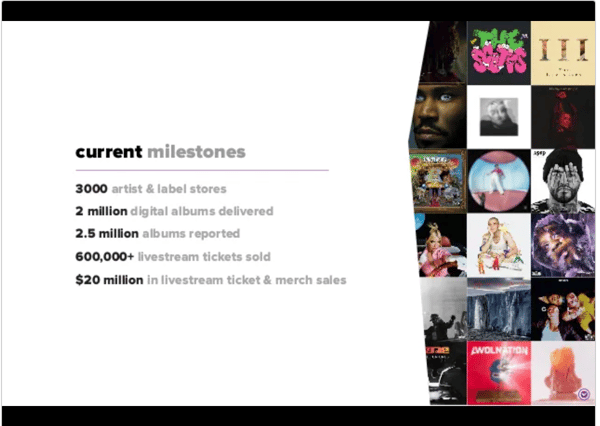
6. Information about your competitors
For this slide, list your competitors and how your product or service compares to them.
Pro tip: Always highlight your company’s unique competitive advantages over your competition. However, avoid belittling your competitors.
Look how Snapchat compares itself to other platforms in terms of advertising in this slide.

7. Your marketing strategy
After convincing your audience about the problem, the solution, and how your product or service is different from the competition, your next slide should answer the question – how will you market your solution, and how long will it take?
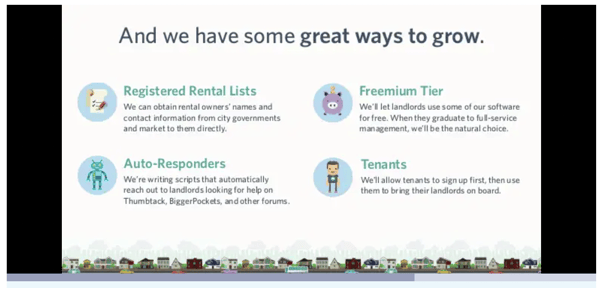
This section of your marketing deck should answer:
- How will you market to prospective customers?
- What kind of marketing assets are you going to create?
- What methods and means will you use to reach your customers? Why do you think they will work? Provide any proof you have that this can be achieved.
- What’s your pricing like?
- What are your target conversion rates?
You should be able to answer questions about your marketing funnel when presenting this slide.
8. Financial information
A slide highlighting your financial forecast is one of the most crucial components of your marketing deck.
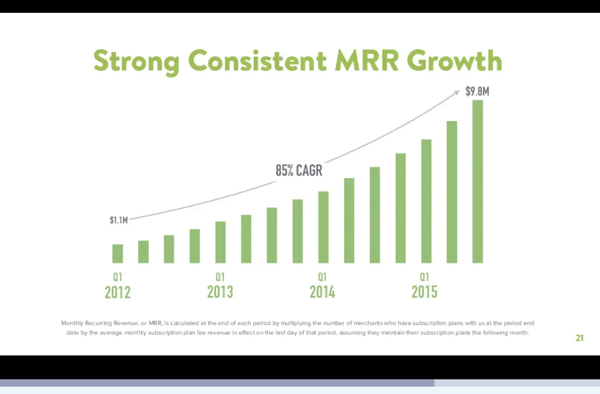
Show your audience that you and your team can make money from your product or service. After all, investors and partners want to know if you can grow the funds they’ll invest in you.
Meanwhile, if your marketing deck is specifically for clients and customers, focus on how your product or service can help them save money in the long run.
9. Information about your team
For this section, highlight your core team members' domain expertise, skills, and success. Business partners and investors aren't just investing in your business; they’re also putting their trust in you and your team. You need to show them that the people behind the product or service are capable, sensible, and trustworthy.
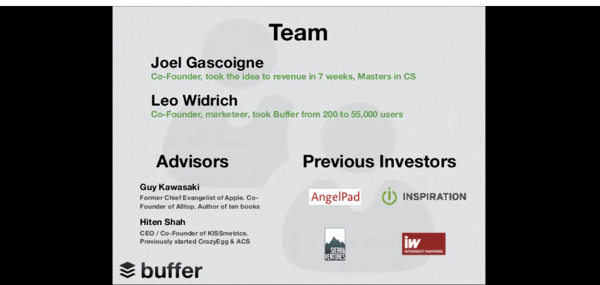
10. Social proof
One better way to inspire investors or customers' confidence is to let them know that other people like them trust you.
For this slide, show off the positive reviews and feedback you've received in media publications, social media, and review sites like G2 . Bonus points if you can include feedback from recognizable brands and influencers in your niche.
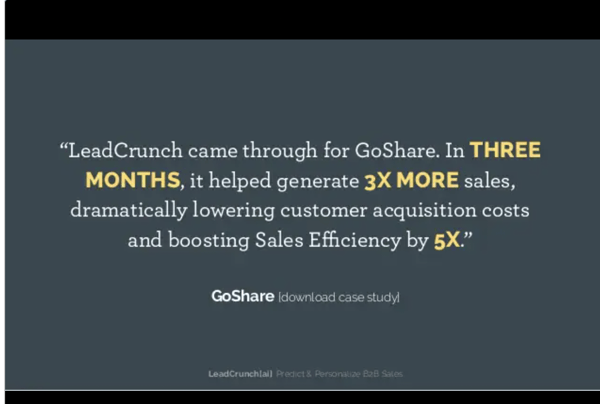
11. Your contact information
Finally, add your contact details (again!) to the final slide in your marketing deck. You can show this slide while answering your audience's questions about your presentation.

How to build a marketing deck that works
Now that you already know the essential components to include, here are some helpful best practices for creating and designing powerful marketing decks.
1. Know your audience or investors
The better you know your audience, the more likely you’ll tell a story or share information that truly resonates with them. For example, find out what kind of businesses they support and learn about their best practices. Learning more about your target audience is the first big step toward a great pitch deck.
2. Use easy-to-read fonts
Your deck should be easy to read and understand. Always use simple and legible fonts. The best fonts for presentations are bold and big enough to make them stand out from the rest of your text. However, don't overuse strong fonts. Glaring fronts hurt readability and aren't a good sight for sore eyes.
3. Ensure that every slide in your deck has a purpose
When creating a deck, you should know where you're heading. Each slide should answer:
- What is the biggest takeaway?
- Does this content convey what we want to say?
An aimless presentation serves no good cause and is confusing for both your team and audience. When you know what you intend to convey with your slides, your audience also understands what to take home from it. You need to bring out the unique value with a defined purpose.
4. Consider brand consistency
Your marketing deck presentation is like your brand ambassador . Your audience might take photos or screenshots of your slides to share or save for reference.
Make sure the font, color schemes, and format of each slide in your presentation are consistent so that it's used as an example, not discarded as another convoluted graphic. Pitch decks with multiple fonts, color schemes, and backgrounds can often look amateurish and make you appear less trustworthy.
5. Aim for simplicity
As with fonts, aim for simplicity throughout the deck. Avoid walls of texts or even bullet points (a common practice) in your slides when possible. Use images or keywords the audience can connect to while listening along.
Simplicity adds to the visual appeal, enhancing the overall customer experience. If your presentation is simple and naturally flowing, it gains more real estate and attracts a larger audience.
6. Tell a story
You have probably read about this best practice many times. It's thrown around a lot because it rarely fails. Sharing a story keeps people interested in what you have to say and can also help make your presentation more compelling.
Regardless of the purpose, your decks should aim to create a brand story. It should answer the what, why, and how of your brand's values and how they relate to your customers.
7. Use visuals
Our brains favor visuals over plain text. This isn't just an observation, but a proven fact. Therefore, make an effort to use images, infographics, icons, graphs, and similar visual elements in your presentations.
Also, remember not to overdo the graphics. Only use relevant visuals, and don't clutter your deck just because you think your audience will find them appealing. Too many visual or graphic elements can, in turn, impair readability and put the viewer off.
8. Always cite your facts
It's always good to reference every claim or statistic in your deck to build credibility. All your sources should also be recent and up-to-date.
A best practice is to quote only relevant facts and figures essential to support your argument or solution. Find a way to link them to the proprietary or original source.
9. Break the rules
Lastly, don't be afraid to break the rules!
For example, your research tells you because your audience loves to talk about growth strategies, you need to talk a lot more about traction than how your product works! With this information, feel free to spend more time highlighting growth tactics in your decks.
What's more important is that your deck presentation flows smoothly.
Examples and templates of effective marketing decks
Here are a few examples of effective marketing decks and templates that you can use.
1. Zuora
Andy Raskin, a strategic narrative consultant, shares several reasons why this presentation from Zuora is the "greatest sales deck" he has seen.
Source: SlideShare
These reasons are:
- It talks about a significant, transformative change
- The winners and the losers of the change
- How Zuora can help its audience be part of the change
Leo Widrich, the co-founder of Buffer, writes how this marketing deck helped them raise half a million dollars . He spoke about how traction is one of the most important elements of a pitch, particularly if you're new to presenting your decks.
Source: Buffer
3. Velocity Partners
This deck by Velocity Partners , a B2B marketing agency, is a perfect example of a brand that isn’t afraid to break the rules.
With 50 slides (the standard recommendation is to have 20 slides or less), this deck talks about the content marketing deluge and how brands can rise above the noise.
Marketing deck templates you can use
- Sales demo deck template
- Marketing strategy deck template
- Product marketing deck template
- Marketing pitch deck templates
Know your audience first and make better marketing decks
Regardless of your niche or industry, creating better marketing decks boils down to getting to know your prospective audience as much as possible. The more you know and understand their needs, the more persuasive and engaging your deck will be.
You got this!
Struggling to create a presentation that'll stand out? Explore presentation software to create interactive slide decks and get your message across.

Your best presentation yet
Create hands-on presentations and improve your virtual pitch with presentation software.

Kai Tomboc is an experienced content designer and writer on all things healthcare, design, and SaaS. She used to be a nurse and a telemarketer in her past lives. She lives for mountain trips, lap swimming, books, and conversations over beer.
Recommended Articles
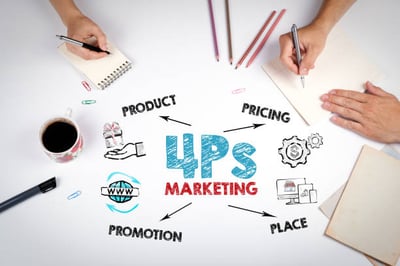
Contributor Network
The 4 Ps of Marketing: How to Apply Them to Your Business
Marketing a business goes beyond advertising.
by AbdulGaniy Shehu

What Is Promotional Marketing? (+6 Ways to Use It)
You've come up with a fresh business idea, created a new product, or rebranded an old one.
by Anna Konovalova

What Is Interactive Marketing? Check Out These Strategies
Are you looking for ways to increase your engagement and overall sales? Interactive marketing...
by Shivani Mody
Never miss a post.
Subscribe to keep your fingers on the tech pulse.
By submitting this form, you are agreeing to receive marketing communications from G2.

Fill your (MarTech) cup
Stay current on SaaS-y news and the latest MarTech trends delivered in a 5-minute monthly newsletter.

Forget PowerPoint: This is the AI presentation app of the future
I t’s tough to think of two words that seem more at odds with each other than “beautiful” and “presentation.” I mean, have you seen a PowerPoint slide deck lately?
That disconnect is something Mitch Grasso’s been grappling with for years. In fact, it wouldn’t be a stretch to describe it as motivating his life mission at this point—to achieve the impossible-seeming feat of turning mundane digital presentations into something both beautiful to behold and enjoyable to create.
“‘I love PowerPoint’ is not something you hear a lot of people say,” Grasso deadpans. “People hate PowerPoint, and they’re always frustrated . . . but it’s not really PowerPoint that’s the problem.”
Grasso firmly believes the issue is less the tool itself and more the process it puts you through—something that applies equally, he says, to Google Slides and other PowerPoint alternatives. And that’s why he’s come up with a web-based and native desktop presentation platform called Beautiful.ai , which he describes as the “anti-PowerPoint.”
This is actually Grasso’s second stab at solving the presentation puzzle. In 2007, he founded SlideRocket , a startup he sold to VMware a few years later. But before you jump to conclusions, hang on a sec: While his latest creation does sport two increasingly common letters at the end of its name, Beautiful.ai isn’t yet another rushed-out generative AI also-ran. Beautiful.ai has been around for nearly a decade now. And the seeds of its soul stretch back to Grasso’s earlier creation, when he first started exploring how presentations could be reinvented.
As someone who’s used the service for a while, let me tell you: Even if you’re late to the Beautiful.ai party, you’ll be very glad you got there.
The Beautiful.ai presentation philosophy
The first thing you notice when you get into Beautiful.ai is almost shocking: The service is, dare I say it, actually delightful to use. Grasso really did identify an area ripe for reinvention: Beautiful.ai takes all the typical pain points out of presentation creation and turns it into a simple process that’s surprisingly swift and pleasant.
The crux of the whole experience revolves around Beautiful.ai’s intelligent algorithms for helping you find the best way to format and design whatever type of presentation you’re building. If you’re starting from a blank slate, the app gives you a handful of suggested themes to get things going—motifs like “Minimal,” “Classic,” “Bold,” and even “Cheeky.” Or, if you’d rather, you can pick from a library of starter templates for everything from sales pitch presentations to marketing reports and all sorts of other common company needs.
But it’s once you get into the presentation that the magic really becomes apparent.
With each new slide you create, Beautiful.ai encourages you to pick from a sprawling menu of common slide design frameworks, all of which are available as part of the service’s $144-a-year Pro-level subscription (which includes a 14-day free trial). You could use simple text boxes, for instance, or a fancy photo grid. You could build all sorts of data-centric charts and visual info representations. You could create a timeline graphic of a company’s journey, with key moments highlighted along the way. Or you could give yourself blueprints for org charts, quote showcases, team member introductions, and even slick-looking product screenshots—all with a single click.
And then, as you’re working on slides, Beautiful.ai intelligently adapts the design at every step along the way—putting formatting on “autopilot,” as Grasso describes it. As you add additional elements, the software instantly shifts other elements around and makes everything look good—with virtually no time or effort required. You absolutely can take control and customize things as you see fit, if the urge strikes, but in my experience, very little adjustment needs to be done.
This automation is where the AI in Beautiful.ai’s name comes into play. While AI has now colloquially come to be understood as involving generative chatbot-like technology—à la ChatGPT or Google Gemini —Grasso latched onto the term in the pre-GPT days, when it referenced all manners of algorithm-driven adaptation.
“I was less concerned with the set of technologies that were behind us and more about the experience of automating and influencing the way your presentations are created,” he says.
It’s something the Beautiful.ai team has come to refer to as “design AI,” a fancy way of referencing the logic surrounding how elements on the screen are automatically laid out and optimized for you as you work. And that’s the most important value Beautiful.ai provides. It’s what drew me to the service a few years ago and has kept me coming back to it ever since.
Reimagining the ‘AI’ element
As simple as it already was to start a new Beautiful.ai presentation, the relatively recent addition of generative AI into the service adds even more convenience into the equation, for anyone wanting to go down that path.
Now, I don’t want to overhype it: This part of the service is probably its least unique and useful element. But it works admirably well as an extra option, and it presents some intriguing possibilities for going beyond the standard gen-AI capabilities present in so many tools these days.
When creating a new Beautiful.ai presentation, for instance, you can now opt to start by providing a plain-text description of what you need—”a presentation on the workplace transformation and the future of work,” “an investor pitch deck for a Series A SaaS company in the B2C FinTech space,” or “a board deck for Q1 revenue, growth, and new customers,” to use a few of the service’s sample prompts. Beautiful.ai will then pull in publicly available data and build a complete presentation for you. You’ll almost certainly need to edit and refine it, but you’ll start with something , at least—and you might just find a fair amount of your legwork finished before you even begin.
You can also provide extra context for training the AI around your specific info and data—by uploading a file, referencing a web link, or pasting in text—and once you’re in the midst of editing a presentation, you can click a special AI button to summon tools for generating text, shortening or lengthening text, and rewriting text to all sorts of other specifications.
The beauty, though—as it were—is how this is just a first step with Beautiful.ai. It’s what happens next , with the software’s design smarts, that makes it all matter.
“Generative AI is great for getting you started,” Grasso explains. “But the continued editing and the continued manipulation of the content that it’s created is the important part and why we’ve continued to be successful.”
Grasso says only about 20% of the service’s one-million-plus users are regularly accessing the generative AI features, but their presence alongside the public fascination with AI at the moment has absolutely led lots of new people to find Beautiful.ai lately. The service’s active user base increased three times over in 2023, in what Grasso describes as an “unprecedented” level of growth. And many of those explorers have ended up sticking around for the long haul—not because of the generative AI elements, Grasso believes, but because of Beautiful’s longer-standing central advantages.
“It made us more powerful kind of overnight and added this great functionality, but it doesn’t really change the core reason for why Beautiful exists,” Grasso says. “You can’t just wrap ChatGPT in an interface and call it a day.”
That realization makes Grasso especially optimistic about Beautiful.ai’s future, even at a time when the term “AI” is getting tossed around endlessly and everyone from Microsoft and Google to smaller startups are experimenting with inserting extra smarts into presentation software.
“What it really comes down to: Is it something that you’re going to use again and again and [that] really provides value?” Grasso asks. “And at least so far . . . I haven’t really seen that so much from the competitors yet.”
Grasso is focused next on both expanding Beautiful.ai’s generative AI capabilities even further and finding other places where the service’s approach could be beneficial—whether that’s within documents or other visual creations where design and knowledge work intersect.
“Productivity is about making people more productive [and] making their work beautiful, whether that means how they work or the output of their work,” he says. “And there are a lot of opportunities to take this technology that we’ve been perfecting over the last half dozen or so years and apply it to these other mediums.”
For now, Grasso is content with the knowledge that he’s building on the dream he’s been chasing since 2007 and—for the moment, at least—leaving tech’s traditional presentation titans in the dust behind him.
Discover all sorts of exceptional tech tools with my free Cool Tools newsletter at The Intelligence . You’ll get a new off-the-beaten-path treasure in your inbox every Wednesday!
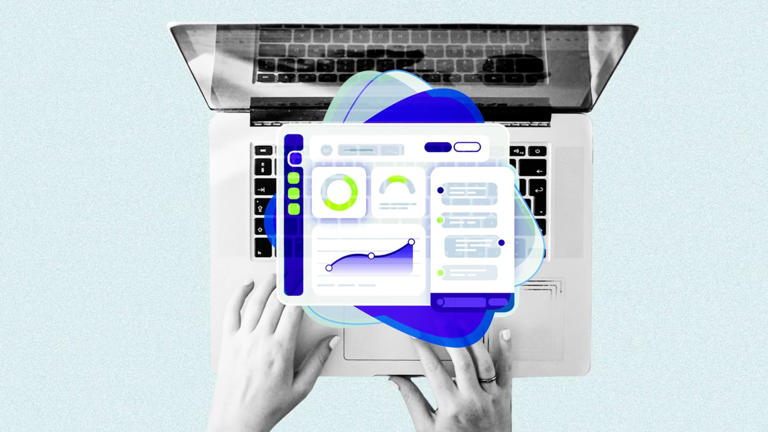
Screen Rant
Jill zarin slams below deck's fraser olender for making her charter trip a "total disaster".
Former Real Housewife of New York City star Jill Zarin blames Below Deck's Fraser Olender for dropping the ball and rendering her trip a disaster.
- It's the head stew's job on Below Deck to ensure things go smoothly, which is why Jill Zarin blames Fraser Olender for her disastrous trip.
- Jill expects high-class service, claiming that her friends paid $45,000, so their demands shouldn't be an issue.
- When asked if she would ever want a do-over, Jill admits she will likely not return to Below Deck.
After receiving backlash for her behavior on the hit Bravo TV show Below Deck , Jill Zarin accused Fraser Olender of making her charter trip a " complete disaster. " Jill is a popular former star of The Real Housewives of New York City , and Jill has always been known for her picky and quirky personality, which can often lead to demanding behavior that she calls " helpful ." She recently became a guest star in Below Deck season 11 , which follows the indoor and outdoor crew of luxurious mega yachts as they give their charter guests the trip of a lifetime.
"It was the head stew’s job to make sure things went seamlessly, and I kind of blame him."
During her time on the St . David, Jill made quite an impression on not only the interior and exterior crews but also the chef, who she distracted from taking care of the actual primary guest. Jill, however, is not willing to take the blame for her constant complaining , claiming that she likes what she likes and has no problem with that.
During an episode of Juicy Scoop with Heather McDonald, Jill said, "It was the head stew’s job to make sure things went seamlessly, and I kind of blame him for the trip being kind of a total disaster for my friends. "
Jill Zarin Admits Her Friends Wanted To Be On TV
Jill zarin does not think she will return to below deck.
Jill received negative reactions for her behavior on the mega yacht, with the common perception being that she " hijacked " the trip from the true primary charter guests. Jill claimed that for her friends to charter this yacht for two days, they had to pay a staggering $45,000 , which is why she expected high-class service. When she was asked why she went on Below Deck , Jill responded, " I did because my friends wanted to be on television. I don’t blame them. A lot of people do. And I didn’t mind doing it with them because as long as I am me, I am good. ”
"I don't know anyone who should spend that kind of money and put their reputation at risk."
Jill claimed that the attitudes of the Below Deck season 11 crew made her seem awful , and if they had had a different attitude, things might have come across differently. Jill explained, " I thought they would make me funny, " she said, " because I was giving them so many funny things with the Diet Coke and other things; they cut the rest of it. " When asked if this was an experience she would repeat, Jill replied, " I would not do it again, " she continued. " I don't know anyone who should spend that kind of money and put their reputation at risk. "
20 Best Reality TV Shows Right Now
However, not every yacht crew member had an issue with Jill , even though her demands may have seemed " extra ." Interior crew member Barbie Pascual and former Below Deck cast member Kyle Viljoen have both come to Jill's defense. Kyle has said that Jill cannot be called a freeloader because she paid to be on the charter and that asking for snacks is actually a helpful thing to do for the interior crew. Barbie has gone on record to defend Jill , saying she was really fun and went on to say that Jill’s demands made sense.
In the end, it appears that Jill has a point when it comes to the treatment and service she should be able to expect on an expensive yachting trip. While Jill was not, in fact, the primary guest, the items she requested were things that would have benefited the primary charter guests. When someone spends an absurd amount of money on a luxury vacation, there are standards they expect , including specific preferences if that is what they want. Either way, Jill is not likely to be the most demanding or picky guest aboard the yacht this season.
Below Deck season 11 airs Mondays at 9 p.m. EDT on Bravo and is available to stream the next day on Peacock.
Source: Juicy Scoop with Heath McDonald /YouTube
Below Deck is a popular reality TV franchise that focuses on a group of crew members as they work on luxurious yachts and cater to their client's needs. After the original series proved to be a success, Bravo developed a handful of spinoff shows including Below Deck Selling Yacht, Below Deck Adventure, Below Deck Down Under, and Below Deck Mediterranean.

IMAGES
VIDEO
COMMENTS
The easiest way to understand the presentation deck meaning is that it is a set of slides put together in the form of a presentation, usually for business purposes but also often used in other areas like academic environments or public speaking events. The term "deck" derives from the old analog technology by which a physical set of ...
A PowerPoint slide deck is a term used to describe a slide deck or a presentation that is created using Microsoft PowerPoint as the presentation design application. A PowerPoint slide deck usually consists of multiple slides put together to create a presentation. That said, a PowerPoint slide deck is more commonly referred to as a "slide deck ...
Answer key: 1. deck, 2. presentation, 3. deck, 4. presentation. These practice exercises should help you become more comfortable with using presentation and deck in the appropriate context. Remember, a presentation is a formal talk given to an audience, while a deck is a collection of slides used to support a speech or presentation. Conclusion
A PowerPoint slide deck is a collection of slides that are in the same presentation. You'll hear "slide deck" used somewhat interchangeably with "presentation." Like a deck of cards, each slide is a key part of the overall package. Individual slides make up the slide deck , like the cards in a deck of playing cards that are included in this ...
A slide deck's effectiveness isn't just about the content; it's about how that content is organized. The way you structure your slide deck can mean the difference between your audience walking away with valuable insights or leaving halfway into your presentation. Here's how to organize the contents of your deck for maximum impact: 1.
A slide deck (also known as a presentation deck, pitch deck, or PowerPoint slide deck) is a collection of slides that visually communicate your message in a business presentation or pitch. The term "slide deck" harkens back to the days of old slide projectors , where presenters would have slides piled on top of one another with the rest ...
A slide deck is a sequence of slides, or pages, used as visual aids in a presentation or a speech. It's used in business and education to communicate complex information. The slides in the deck are set in a logical order that completes a coherent narrative. The term "slide deck" comes from the original mechanical slide projector which ...
Visme has thousands of editable slide deck templates to help you create presentations quickly. Here's how to customize your slide deck in Visme. 1. Select and Edit a Template. Each slide deck template in Visme has two or more slides. Feel free to add, remove or reorder slides to your deck as you proceed.
1. Innovative Business Presentation Template Slide Deck. Powerful graphics with contrasting tones that add a vibrant vibe to your presentation. This slide deck is ideal for startups, tech talks, or any presentation that wants to showcase a vanguard style in touch with the latest design trends. Use This Template.
A deck is simply a set of digital slides containing images and words, used to get across an idea. You'll often need to make a deck when you want to persuade someone to think about something in a certain way. A presentation is a form of communication that tells a story or expresses an idea. A presentation can include a deck, but it can also be delivered as a video, audio file, or as a speech.
Different Types of Presentation Decks Report Presentation Decks. Report Presentation Decks are integral in academic, corporate, or organizational environments, primarily used for conveying detailed results, findings, or updates. As a result of their structured, formal format, these decks can provide complex information in an easy-to-understand ...
Quick Read. A pitch deck is a visual presentation that tells the story of a business to persuade and engage potential investors. The most common pitch deck slides are introduction, problem, solution, market size and opportunity, product, traction, team, competition, financials and use of funds. Learn from the eight real life pitch deck examples ...
Pitch Deck Definition. A pitch deck is a brief presentation, usually in the form of a slideshow, that outlines the key elements of a business idea or startup. It is typically used to communicate the essence of the business to potential investors, partners, or customers.
Invoke emotions: an emotive pitch deck will resonate at a deeper level with your audience. Promote one idea per slide: any more than this could cause confusion and mixed messages. Provide a face to your business: an audience can relate to an idea if they know who is behind it.
A pitch deck is a short presentation that startups or entrepreneurs put together to help explain a business concept or idea in hopes of getting funding from investors. A pitch deck needs to be simple and easy to understand, professionally designed and include a distinct action for users (potential investors) to take. ...
A pitch deck, often considered the cornerstone of entrepreneur and investor communication, is a brief and visually compelling way to create a presentation that overviews your business. This invaluable tool provides a snapshot of your company's value proposition, market analysis, product details, and more. It's your golden ticket to securing the ...
The term "slide deck" is derived from the old days of presentations when slides were physical transparencies that were loaded into a carousel and projected onto a screen. These physical slides would be shuffled around to create the presentation, much like a deck of cards. Thus, the term "slide deck" was born.
A pitch deck is a concise presentation (in the form of slides) that business owners create to boost the growth of their establishments. It refers to a collection of slides to express an overview of business plans. The display gives clients a wrap-up of business plans, products and services, and operations.
A corporate deck, or corporate pitch deck, is a presentation designed to convey the essential aspects of a business to potential investors, partners, or stakeholders. A corporate deck includes slides that outline the company's business model, products or services, target market, competition, team, financials, and growth strategy.
PowerPoint presentations are slide decks created on the specific software called Microsoft PowerPoint that was released by Microsoft (duh!) in the year 1987. PowerPoint helps create easy and effective digital slide decks; since it is so widely used, it has become synonymous with presentations at large.
Start with an executive summary. Begin the slide deck with a tight executive summary that follows a three-act structure. First, start with stating the current realities. Second, clearly state the problem or opportunity your idea addresses and its potential impact.
A marketing deck, also known as a pitch deck, is a visual marketing presentation of your product or service. It aims to educate potential investors, co-founders, partners, and customers about your product or service. Marketing decks can have different purposes both internal and external. For example, marketers and advertising teams use certain ...
The AI-powered video-creation app rolls out as part of Google Workspace in June, and is intended to assist with slide decks, training videos, and more. ... board meeting presentations, and similar ...
With each new slide you create, Beautiful.ai encourages you to pick from a sprawling menu of common slide design frameworks, all of which are available as part of the service's $144-a-year Pro ...
Clearing the decks That explains why the video game retailer installed a revolving door in the executive suite. It helps get the management team out of the way.
However, not every yacht crew member had an issue with Jill, even though her demands may have seemed "extra."Interior crew member Barbie Pascual and former Below Deck cast member Kyle Viljoen have both come to Jill's defense. Kyle has said that Jill cannot be called a freeloader because she paid to be on the charter and that asking for snacks is actually a helpful thing to do for the interior ...
Q3: 2024-04-09 Earnings Summary. EPS of $0.12 misses by $0.02 | Revenue of $228.81M (4.84% Y/Y) misses by $1.20M. The following slide deck was published by Neogen Corporation in conjunction with ...
Retail Remodel at 647 Fifth Ave, NY Public Hearing Landmarks Presentation Deck. Retail Remodel at 647 Fifth Avenue, Public Hearing for Landmarks Review April 16, 2024 Address: 647 Fifth Avenue, New York, NY 10022 Known as: George W Vanderbilt Residence Built 1902-1905 Architects: Hunt & Hunt Zoning District: C5-3 Overlay Zone: Midtown Tax Block ...